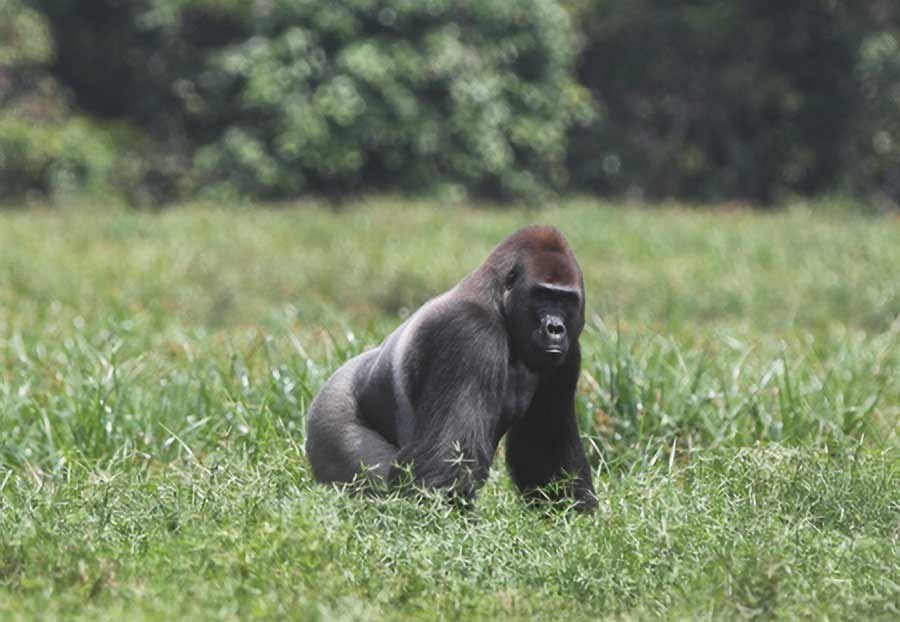
Central African Republic
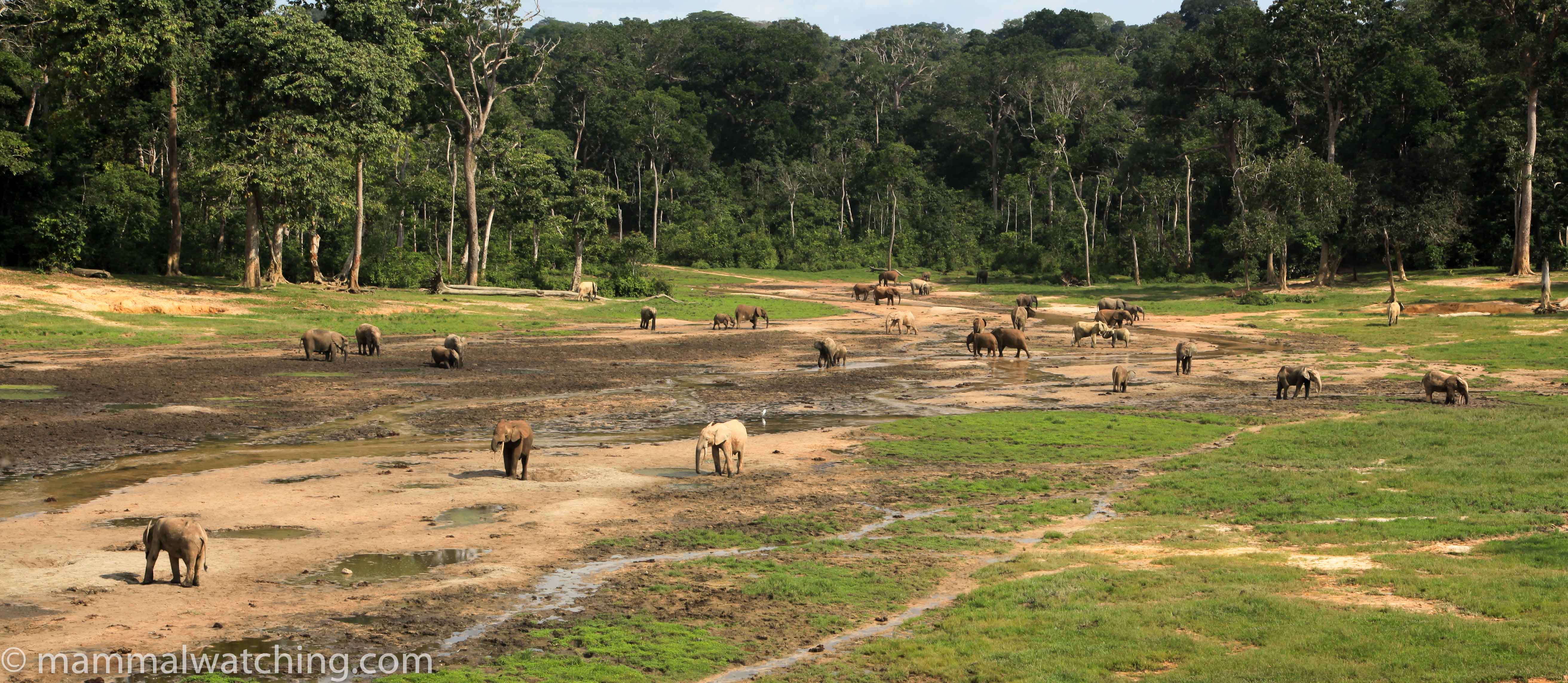
Dzanga Bai
I guess it was 2002 when I first heard about Dzanga Sangha National Park. I was having a beer with Steve Anyon-Smith in Sydney and he told me about a wildlife doco he had seen about bais – natural clearings – in the Congo Basin, including Dzanga Bai. I was smitten. Sjef Ollers’s trip report and the Sangha Lodge list made my longing intensify. Though it was not until November 2011 – 10 years later – that I got there.
I’d been corresponding with Rod Cassidy for several years and in 2009 he told me he’d opened a lodge in Dzanga Sangha. The prospect of visiting the park suddenly got a lot more realistic. But I wanted to come when I had a decent chunk of time, and 3 months long service leave at the end of 2011 was the opportunity I’d been waiting for. Jean-Michel Bompar, bat and cetacean expert and all round good guy, was keen to come too. So just six weeks after I floated the idea we were in Bangui setting off in a Landcruiser for the 13 hour drive to the lodge.
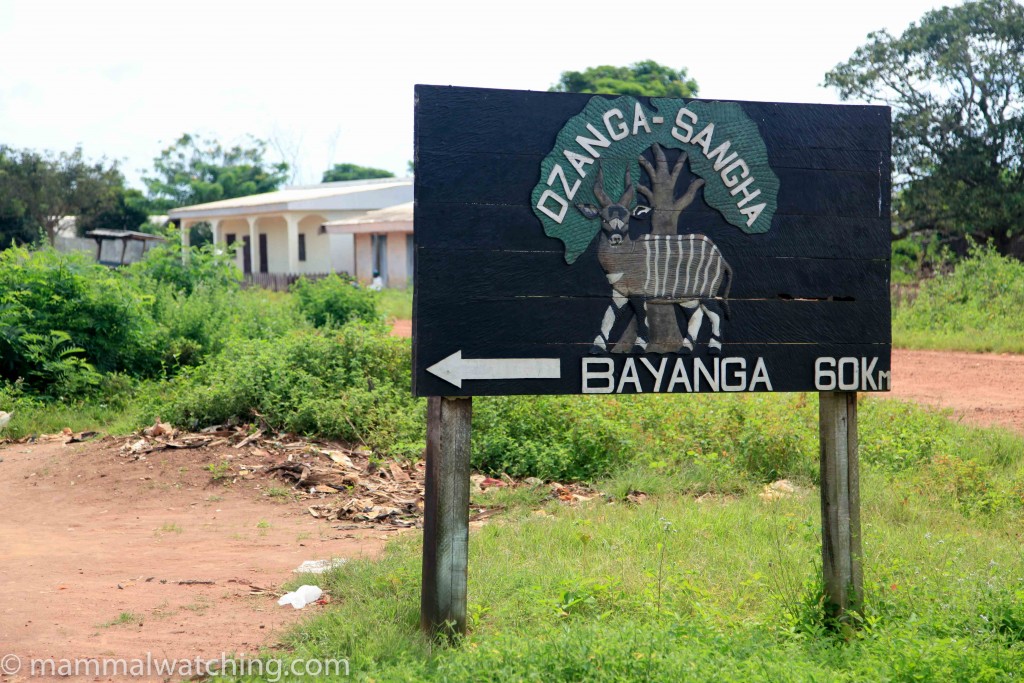
Getting to Sangha Lodge
The Sangha Lodge website has all the information you need about getting to the park.
Most people come from Cameroon or Bangui. From Bangui you can drive or fly. We drove, mainly because its prohibitively expensive to hire a plane for 2 people. That said there are sometimes empty seats on chartered planes that you can buy cheaply if the timing works: Rod can advise on this.
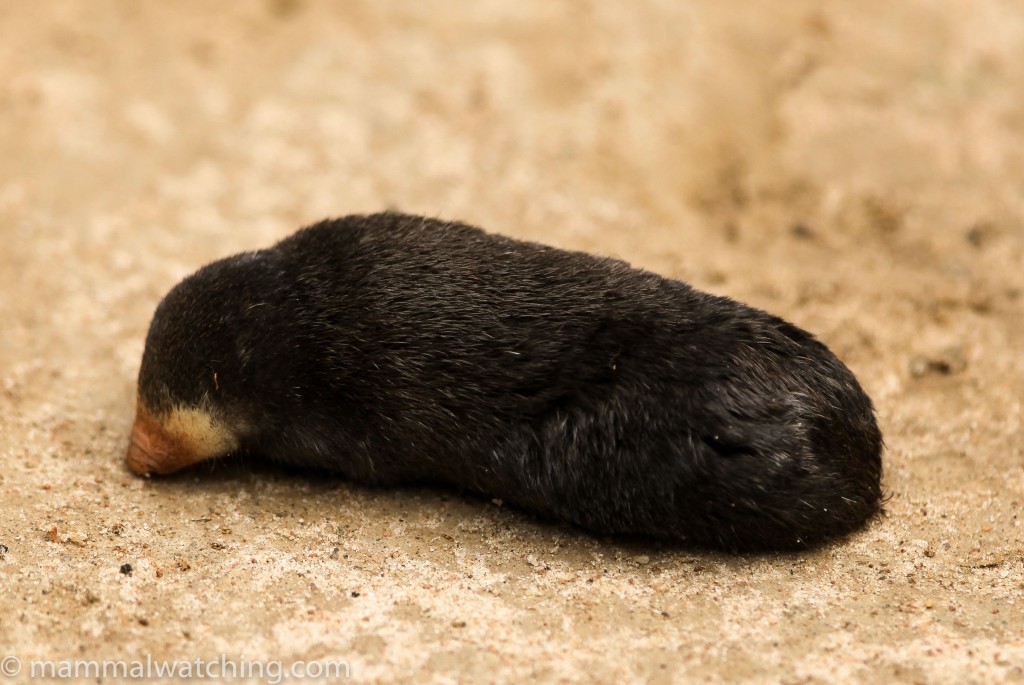
Congo Golden Mole, Calcochloris leucorhinus
But I thought the drive – all 500 kms of it – would be fun. Driving is not cheap either: we paid 120 euros a day for a car with driver but that actually equates to at least 1000 euros because one needs to pay for 8 days at a minimum plus fuel: 2 days for the drive in, and – if you don’t keep the car while you are there – another 2 days for it to drive back to Bangui; followed by the same deal again for the return trip.
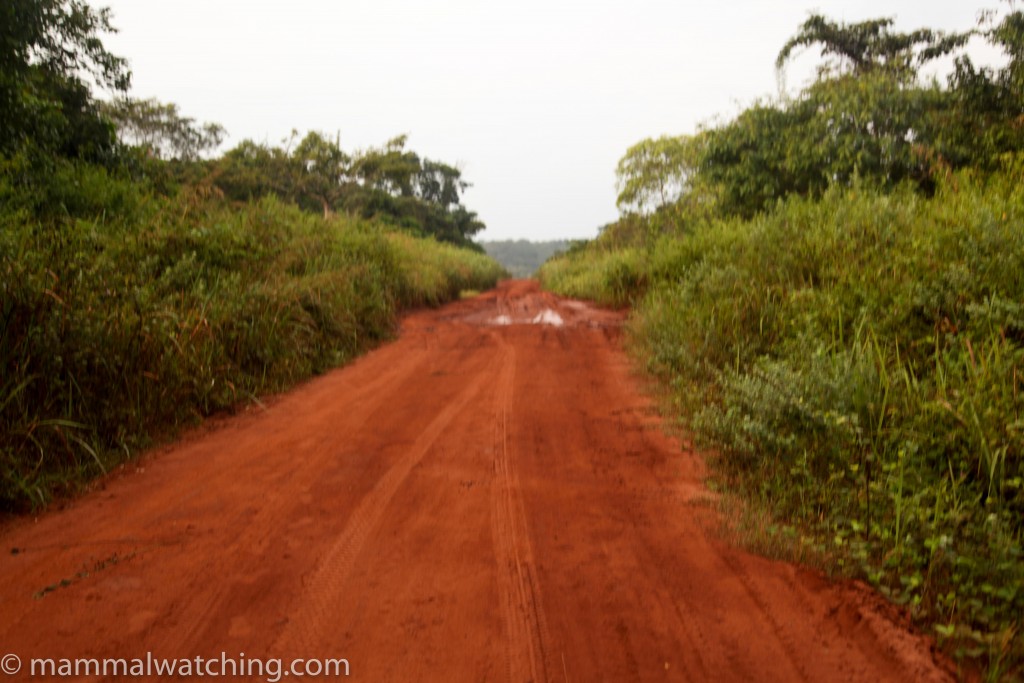
Highway to Sangha
It made sense for us to keep the car for the duration of the trip, because we also needed it at the lodge for trips to the bais and so on. The car – a Landcruiser – was in good condition and Adamou, our driver, was a star. He was always early and ready to work as long as we wanted every night. Though if I ever again have to listen to the 10 song French rap soundtrack he played at least 300 times on the trip I think I might kill him. Again Rod can arrange a car and hopefully arrange for Adamou too. Hiring a vehicle in Bayanga (the town closest to the lodge) is probably more expensive and most certainly less reliable.
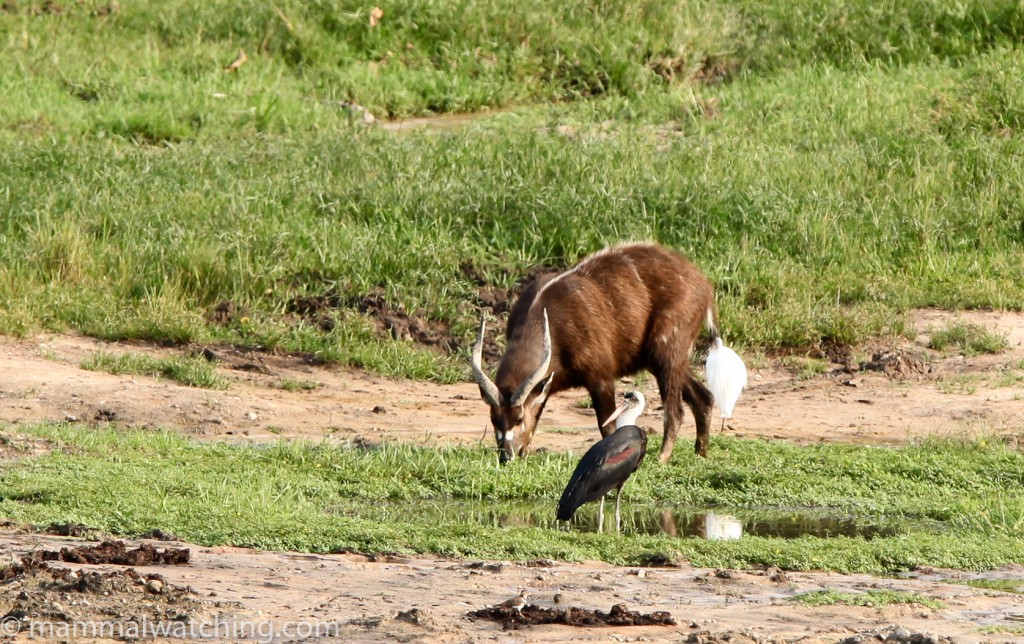
Sitatunga, Tragelaphus spekii
I arrived in Bangui on a Saturday, via Nairobi, and had a day to kill. It was the most under-developed capital I’ve seen. Evelyn, who works for Rod, met me at the airport and looked after me well and we went to a surprisingly good place for dinner. French food with an African atmosphere. A much better combination than the alternative.
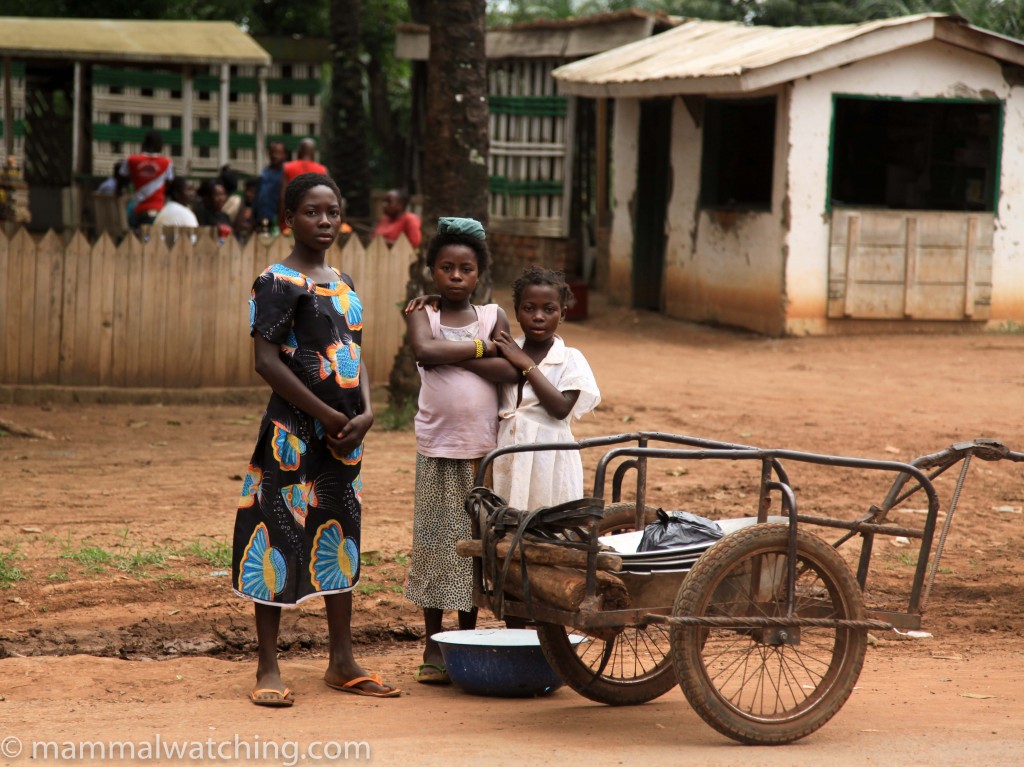
Banguites
Jean-Michel arrived the next afternoon. On a good day you can get to Sangha in 9 hours. November 6 2011 wasn’t a good day. It was the tail end of the wet season and Rod said the road was worse than he’d ever seen it: the drive would take 13 hours. We set off at 3 p.m. as soon as Jean-Michel landed. Twenty minutes later he took a sneaky photo of the amusingly named Brigade des Bimbos police checkpoint, the first of many pointless checkpoints en route. Perhaps they were sensitive about their name (bimbo means the same in French as in English), because the alleged security risk wasn’t apparent to us. But the upshot was a 90 minute delay including a lecture, supervised deleting of the photo and a trip to the brigade HQ for cross-examination before they released Jean-Michel (at least the detour produced some Straw-coloured Fruit Bats).
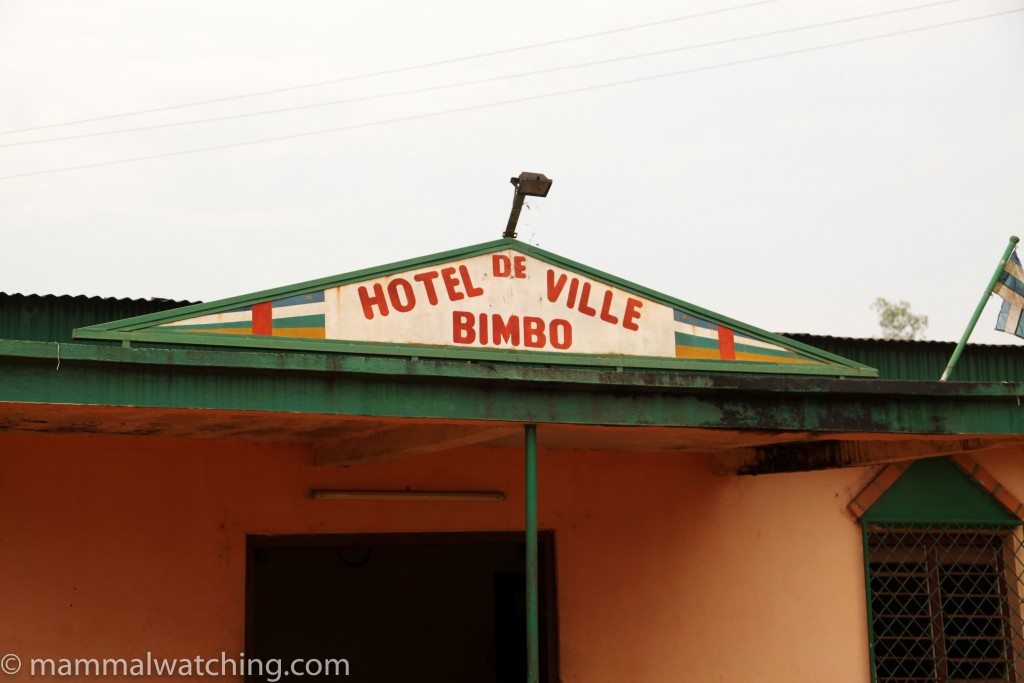
At 5 p.m. we were on our way again. Until the next police checkpoint 20 minutes later. There are a lot of police checkpoints en route. At each you need to produce paperwork – some sort of permit to travel – for the journey to Sangha and there was an issue with ours (some changes had been made in biro to the car’s registration number on the form after we took a different vehicle at the last minute). This was just the excuse they needed to be difficult: that evening the police at each of the first 3 checkpoints took delight in delaying us for 30 minutes at each stop while they quibbled over the paperwork and waited for a financial incentive to wave us through. They did eventually once we’d coughed up the 6 euros they asked for.
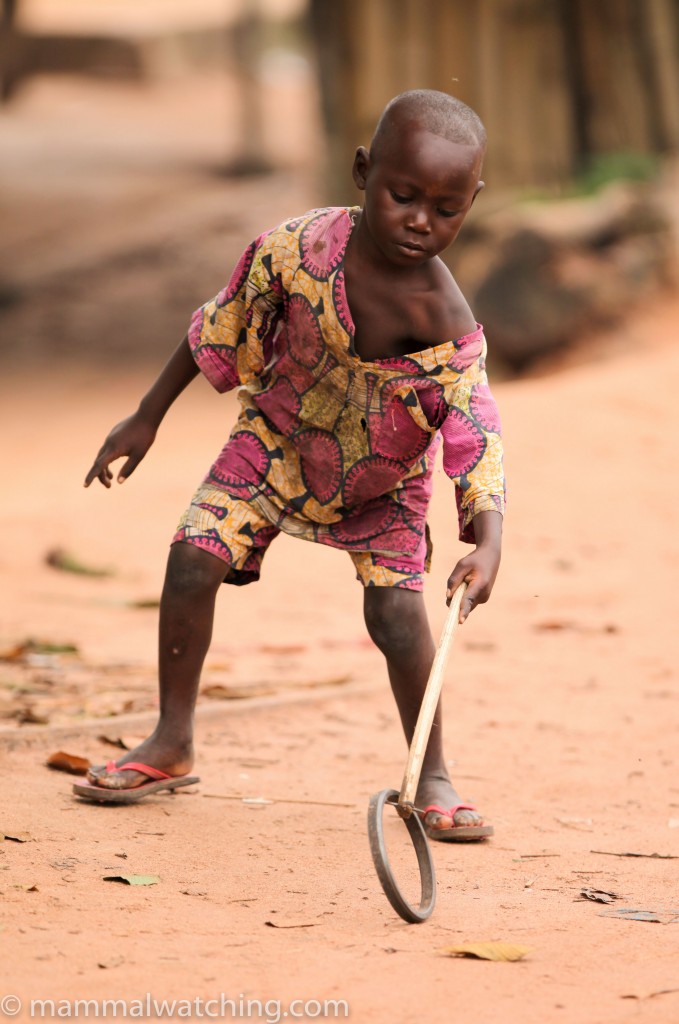
Do you have a permit for that wheel?
We’d planned to spend the night at Boda, the only village en route with any accommodation, and we got there a little after 10 p.m. There was surprisingly little wildlife on the road other than my first good look at a Greater (Savannah) Cane Rat, sitting on the road about an hour before Boda. It stayed put for a good 15 seconds giving a great view before waddling off into the crops.
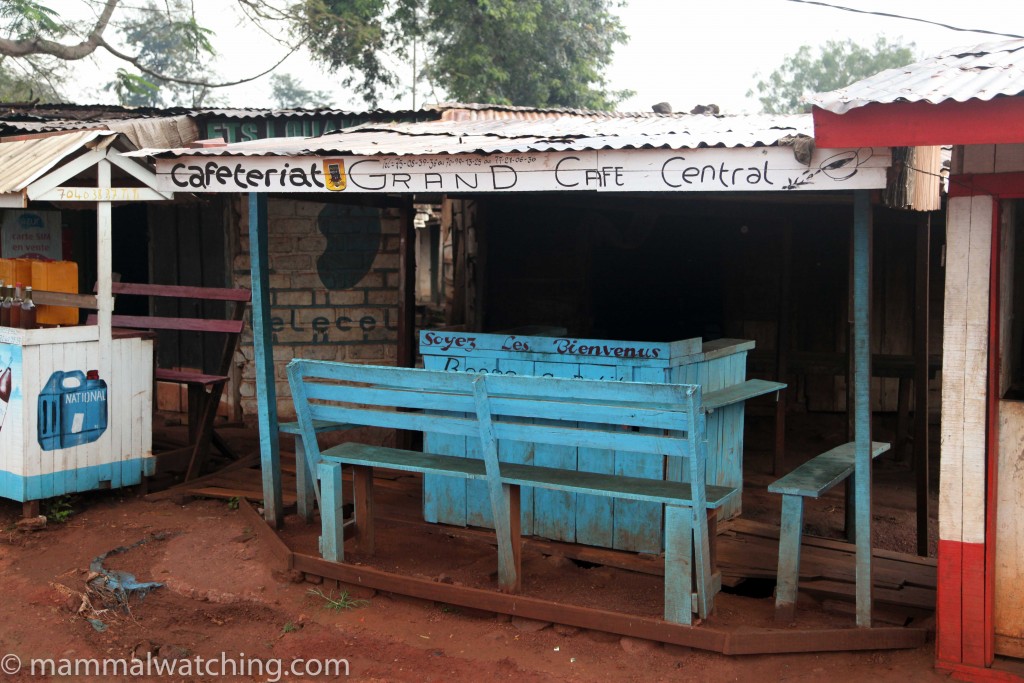
Grande Cafe de Boda
The hotel at Boda was 3 euros a night and overpriced at that. A pillow would have been nice, along with a gun to shoot next door’s chickens. After a coffee at the Grand Cafe de Boda we were on the road again at 6.30 and arrived at the lodge 8 hours later. The long drive was punctuated by some Ba’Aka (pygmy) villages, including one with a roadside stall selling Moustached Monkey meat. We stopped for photos and the villagers offered to catch us a live Pangolin and other stuff when we returned (sadly we couldn’t remember the village in the dark on the way back but I suspect we had been forgotten about).
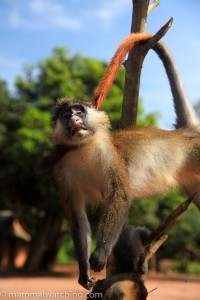
Moustached Monkey bushmeat
The only living mammal was a squirrel – a Green Squirrel most probably – that J.M. saw cross the road. We arrived at the lodge at 14.30 to learn the President had arrived that day unannounced and wanted to stay.
The Area
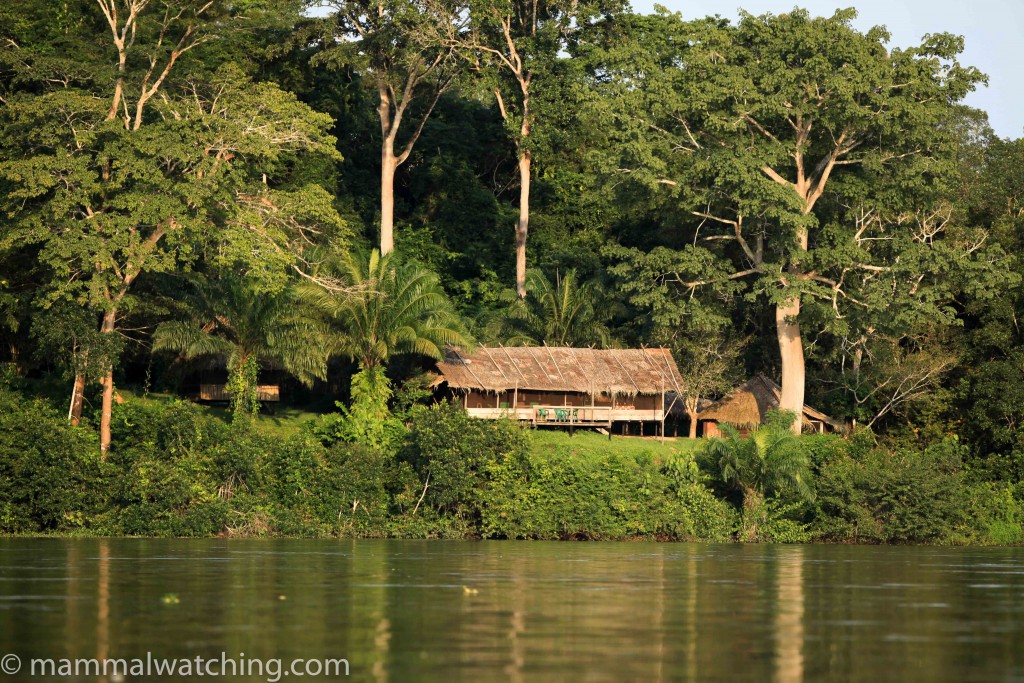
Sangha Lodge
Sangha Lodge is just wonderful. Set on the banks of the Sangha, it has a hypnotising view of the mighty river and the rainforest. And it is perfectly designed, with comfortable rooms that do not go over the top.
It was to be home for the next 9 nights, so long has the President had left space for us. He hadn’t. But Rod managed to shuffle a few people around, and move into his office to free up a cabin. So at 5 p.m. we were having a beer on the deck looking for Black Hawk Bats over the river. It doesn’t get much better than that (well it would have done if I had seen a Hawk Bat).
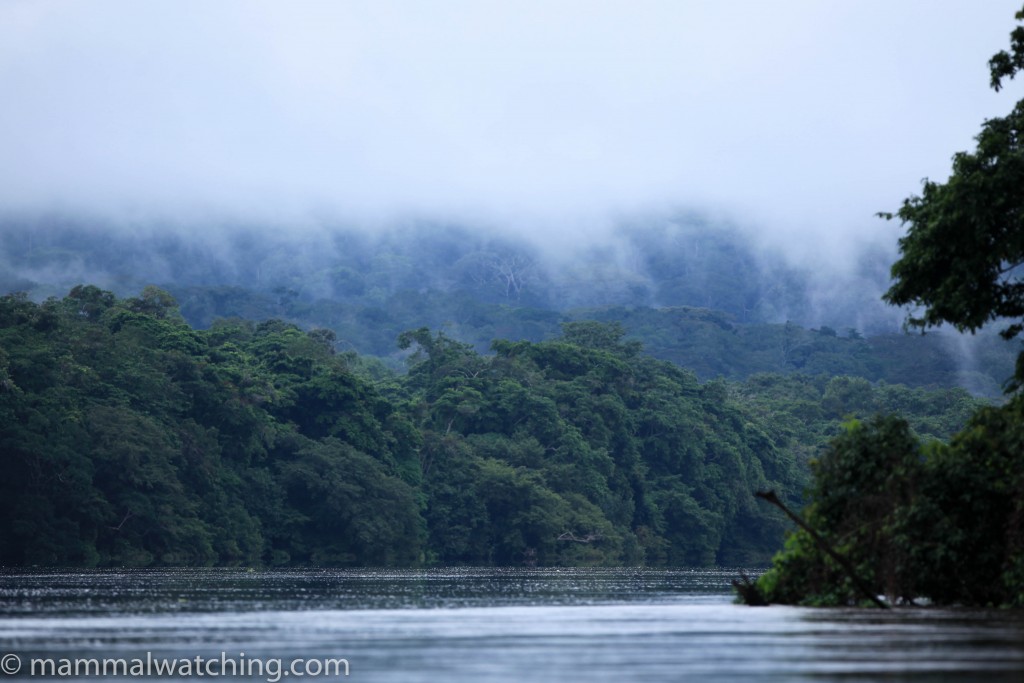
Sangha River
We spent the next 9 days trying to see as many mammals as we could, only stopping to eat very well at the lodge, drink beer and give a fleeting glance to the more impressive birds. Nine days is longer than I have ever stayed in one place for mammal watching and it was not enough time here: you need weeks in a forest like this where the animals come steadily but slowly.
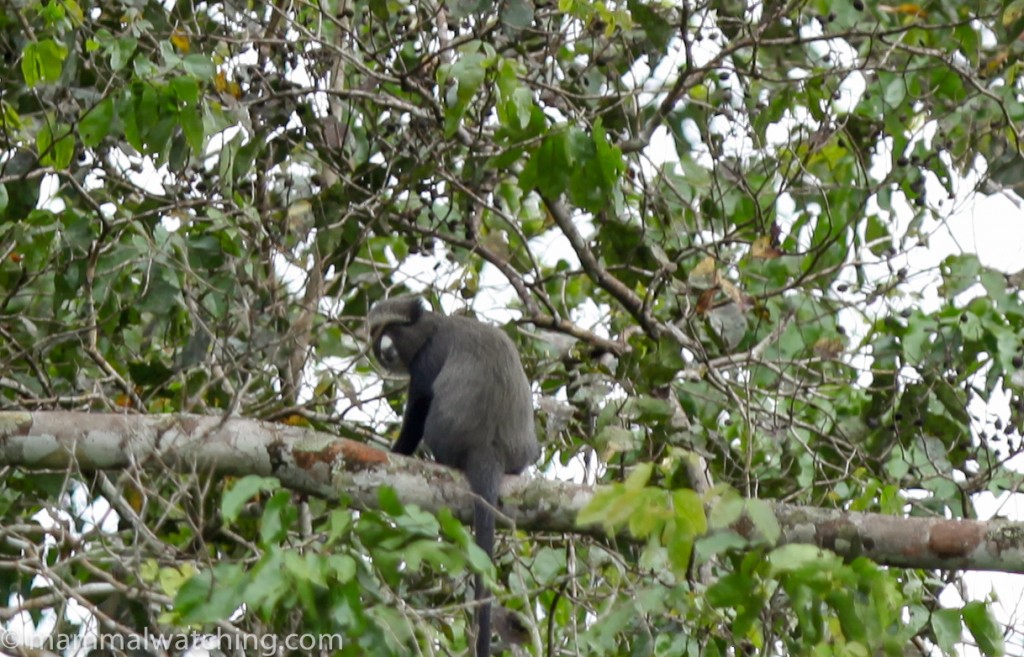
Putty-nosed Monkey, Cercopithecus nictitans
There are four centres of mammal watching activity: Sangha lodge; Doli Lodge; Dzanga Bai; and Bai Hoku. Activities in the latter two areas are managed by the WWF and the national park. Each is dealt with below. Tourists are not allowed to stay overnight at either Bai Hoku or Dzanga Bai but through contacts Jean-Michel and I had with WWF we were able to arrange overnight visits to both places.
There are various other tourist activities on offer, mainly with the Ba’Aka pygmies, including accompanying them on a net hunt for duikers. I wish we had had time to try some of these. The Ba’Aka seem a very special group of people. Desperately poor, and treated as second class citizens by many other Africans, they know the forest like no one else and were a shy, unassuming bunch and always ready to smile. The Ba’Aka staff at Sangha were awesome especially when we asked them to help catch mice in the forest. Trying to encourage the Ba’Aka guides to spot things for us was more of a challenge. I had the impression they saw lots that we didn’t, but just didn’t think to mention it.
Annoyances: Mud and Ants
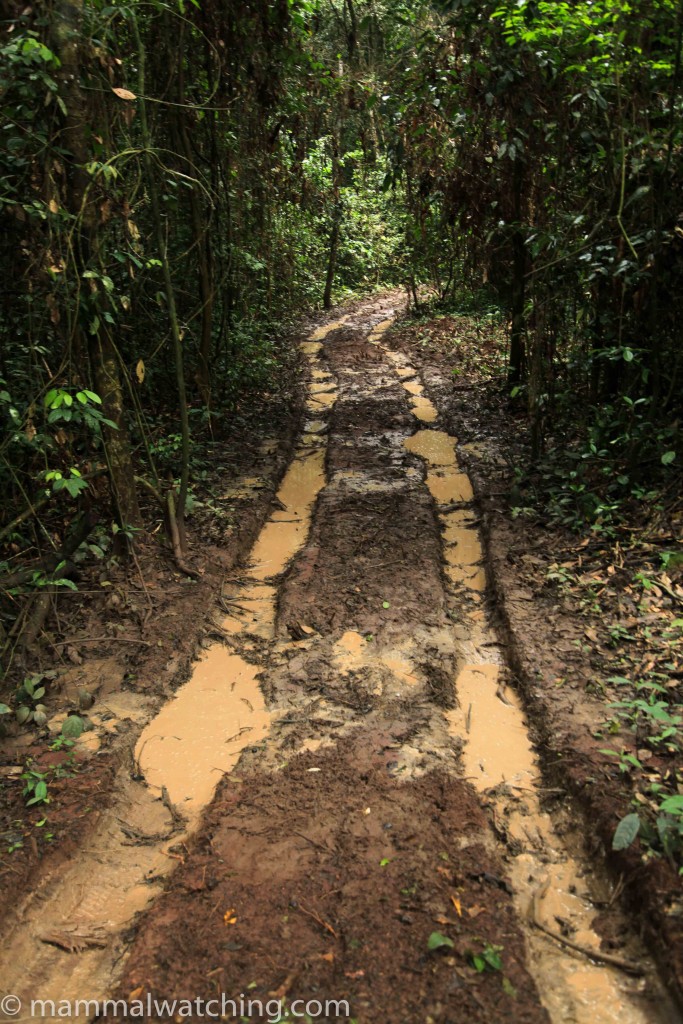
The road to Bai Hoku
If we had believed the Australian, British and French Department of Foreign Affairs’ websites we ought to have been very nervous about a trip to Sangha. But Rod assured me the security situation along the road from Bangui, and in the park, was fine. He is much better informed than the diplomats. With the exception of a few pettily corrupt checkpoints there were no problems whatsoever and I didn’t hear of anyone having encountered any.
The lodge and the park are close to paradise. Or they would be if it wasn’t for the mud and the ants. Mud, of course, is not likely to be a problem in the dry season. It is not really a problem as such in the wet season either. But its a bit of a pain. Because of the frequent river wading I ended up wearing hiking sandals most of the time. But once the sand got into these I quickly got raw patches on my feet so ended up going barefoot when I could. Going barefoot was fine until I had to squelch through thick mud with bleeding feet. When I go back I will take a pair of Crocs: fashion death, but the footwear of choice of the locals.
The ants were a very real problem. I am sure they are the reason the Ba’Aka move so quickly through the forest: you need to be fleet of foot to stop them attacking. There are many species in impressive numbers. Some sting like wasps, others bite extremely effectively (one got me on the quick of my toe and managed to draw more than a few drops of blood). Many others give annoying stings and attack en masse, swarming up feet to legs and into pants if you stop for more than a few seconds. This was a particular problem when I was spotlighting, walking slowly and stopping frequently to look up not down. At least twice I had to strip naked in the forest to battle an army of ants all over me. Worse, they made me lose an animal I had in the spotlight beam that I suspect was something interesting! Bastard ants.
Sangha Lodge Mammals
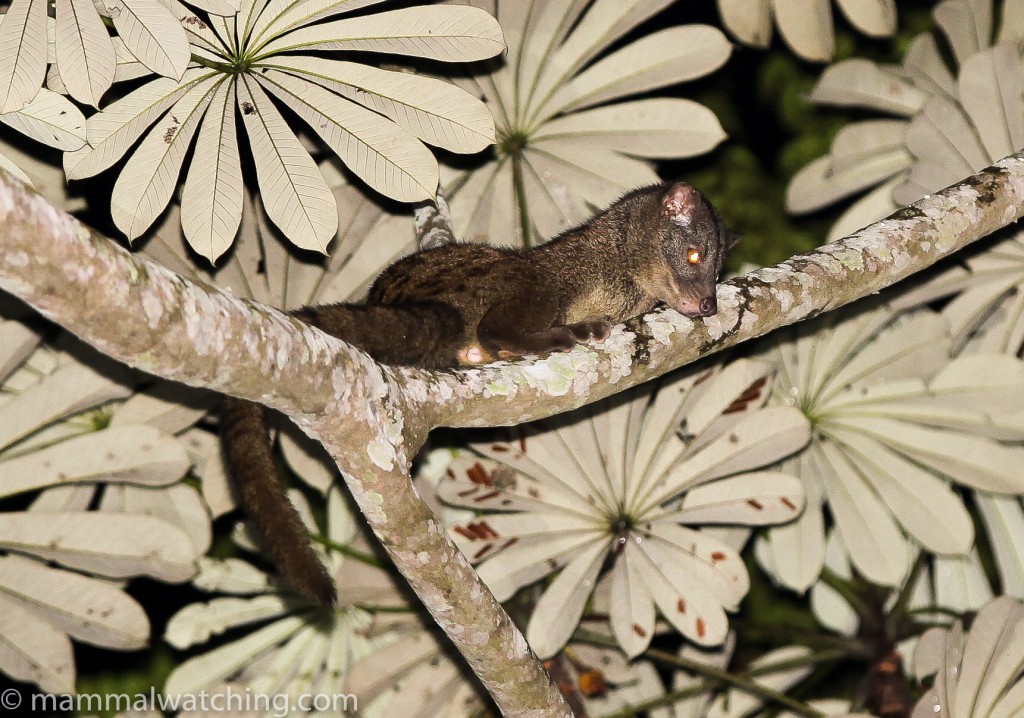
African Palm Civet, Nandinia binotata
Rod has cut three main trails around the lodge. We walked them by day and night and I am not sure any is better than the others. In the day time we saw Putty-nosed Monkeys (and heard them often), Crowned Guenons, a couple of Guereza Colobus (fairly rare around the lodge), Red-legged Sun Squirrels and Lady Burton’s Rope Squirrel.
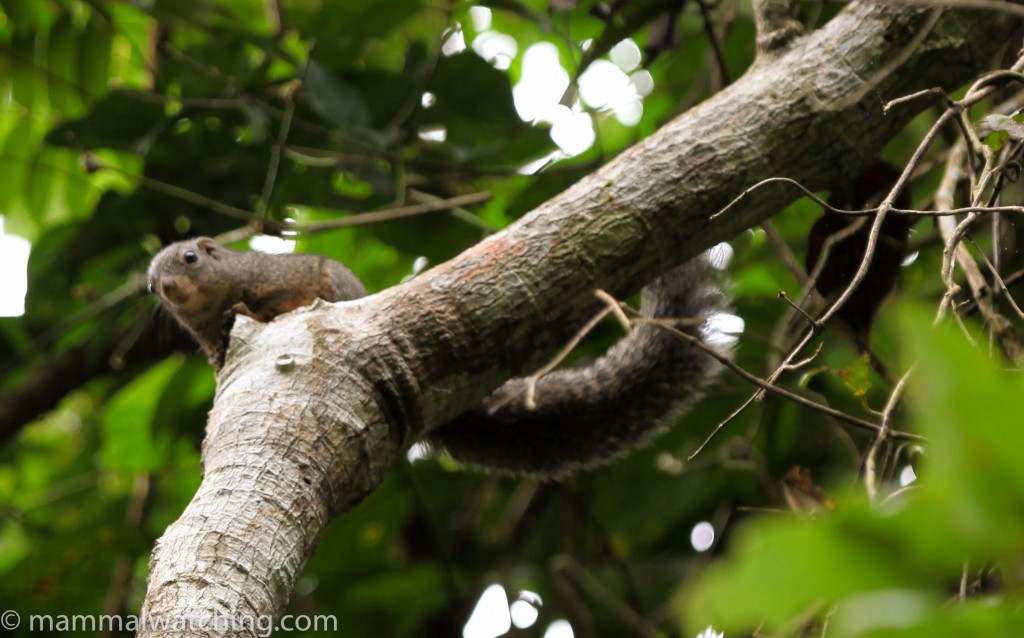
Red-legged Sun Squirrel, Heliosciurus rufobrachium
One of the interesting things about the forest is the way it changed each day. During the first week, for instance, we didn’t hear or see a Rope Squirrel to my knowledge. But then one morning, when the sun came out after a day of heavy rain, Lady Burton’s Rope Squirrels were all over the place.
Early one morning I saw my first Congo Clawless Otter cruise through the creek that separates the lodge from the end of the road.
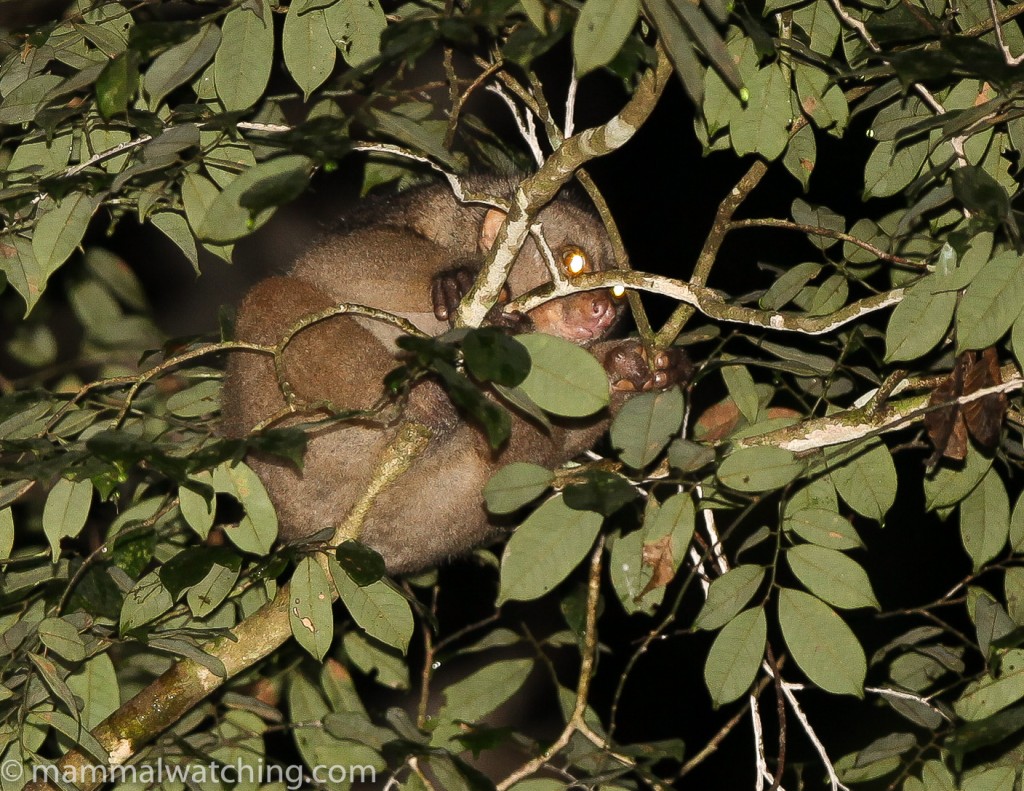
At night, African Palm Civets were very common, especially when we found a fruiting tree: we counted six in the same tree one evening and saw them nearly every night. We also saw many galagos of at least two flavours. A larger galago with a bushy tail that I saw a few times in big trees was probably an Elegant Needle-Clawed Galago though I only got good views of this species around Doli Lodge. The much smaller species that we saw a few times in vine thickets about 3-5 metres up, seem to be Thomas’s Galago. Both Demidorff’s and Thomas’s are in range and are very hard to differentiate when not in the hand, but they have different calls. Rod hears Thomas’s calling all the time around the lodge but never Demidorff’s. In any case it was hard to get decent views of either species. Milne-Edwards’s Pottos are also quite common and we saw a couple around the lodge.
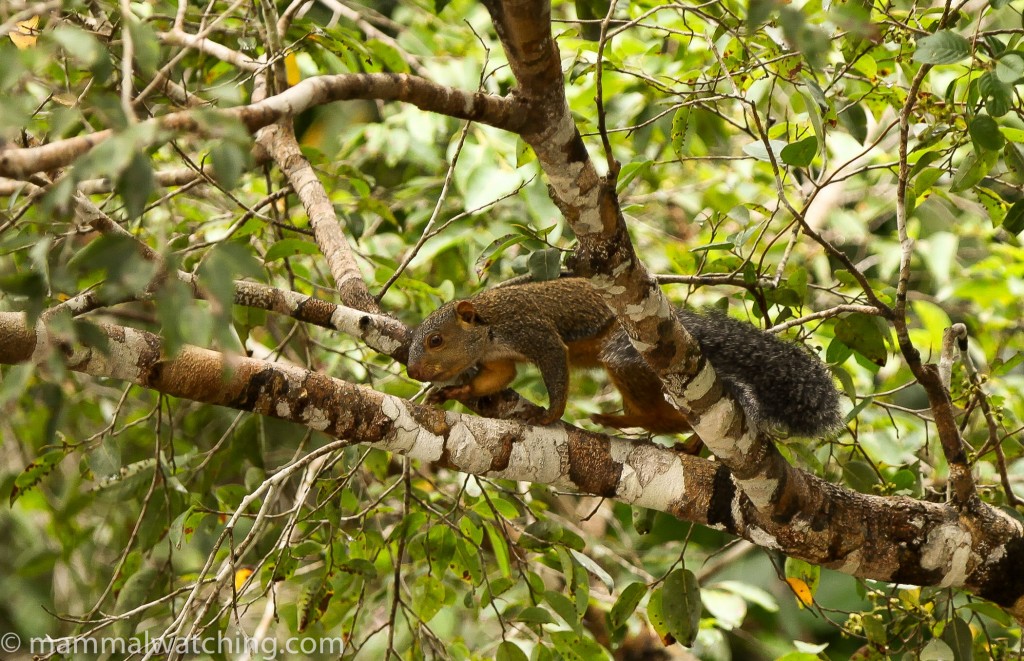
African Giant Squirrel, Protoxerus stangeri
Trips down the river are a good way to look for monkeys especially De Brazza’s Monkey which never venture far from water. During a couple of hours one morning we saw Crowned Guenons and several groups of Putty-nosed Monkeys, plus a very good look at an African Giant Squirrel, but no De Brazza’s. We tried again in the late afternoon, returning to camp with a spotlight and a beer. It was a fun evening but the few things we saw were hard to get a good look at from a moving boat. We did manage to identify a Potto though.
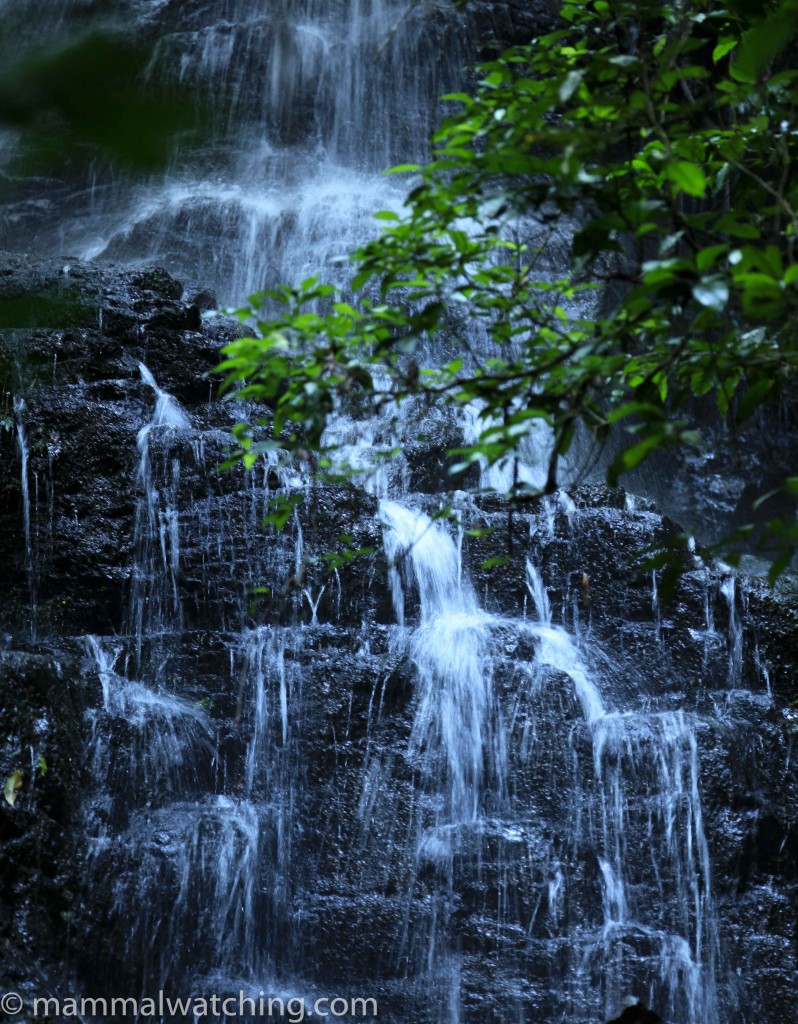
We also visited a beautiful waterfall where Rod, with Sjef Ollers, had found Picathartes (a bird!) breeding and a Brush-tailed Porcupine. Rod has seen Pygmy Squirrels here too as well as bats in the caves behind the waterfall. We saw nothing during a quick visit: no squirrels and the bat caves were full of water.
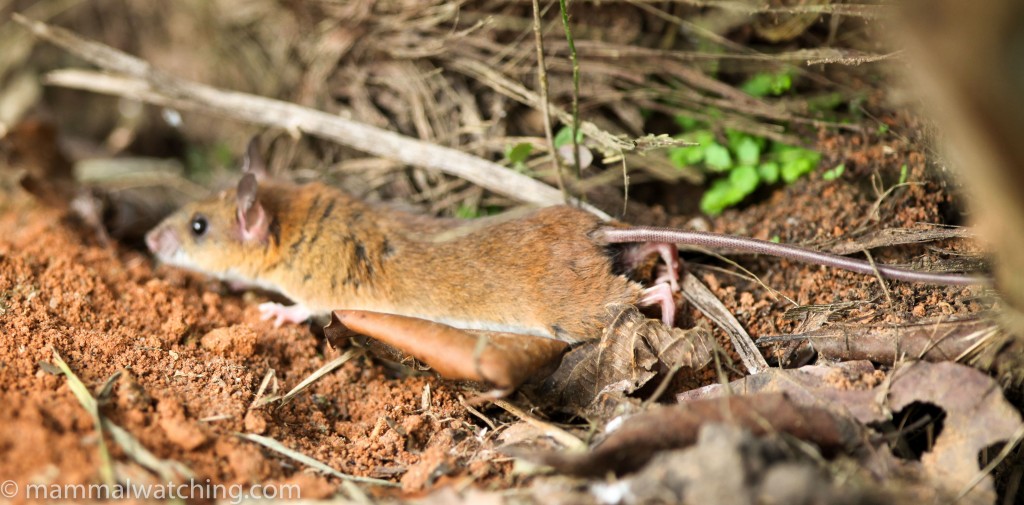
African Wood Mouse species, Hylomyscus alleni or H. walterverheyni
We, the Ba’Aka and Rod’s cat tried to catch small mammals. We had little success. The common long-tailed mouse in the forest was a Wood Mouse, either Hylomyscus alleni or H. walterverheyni. Rod’s cat caught one under our cabin.
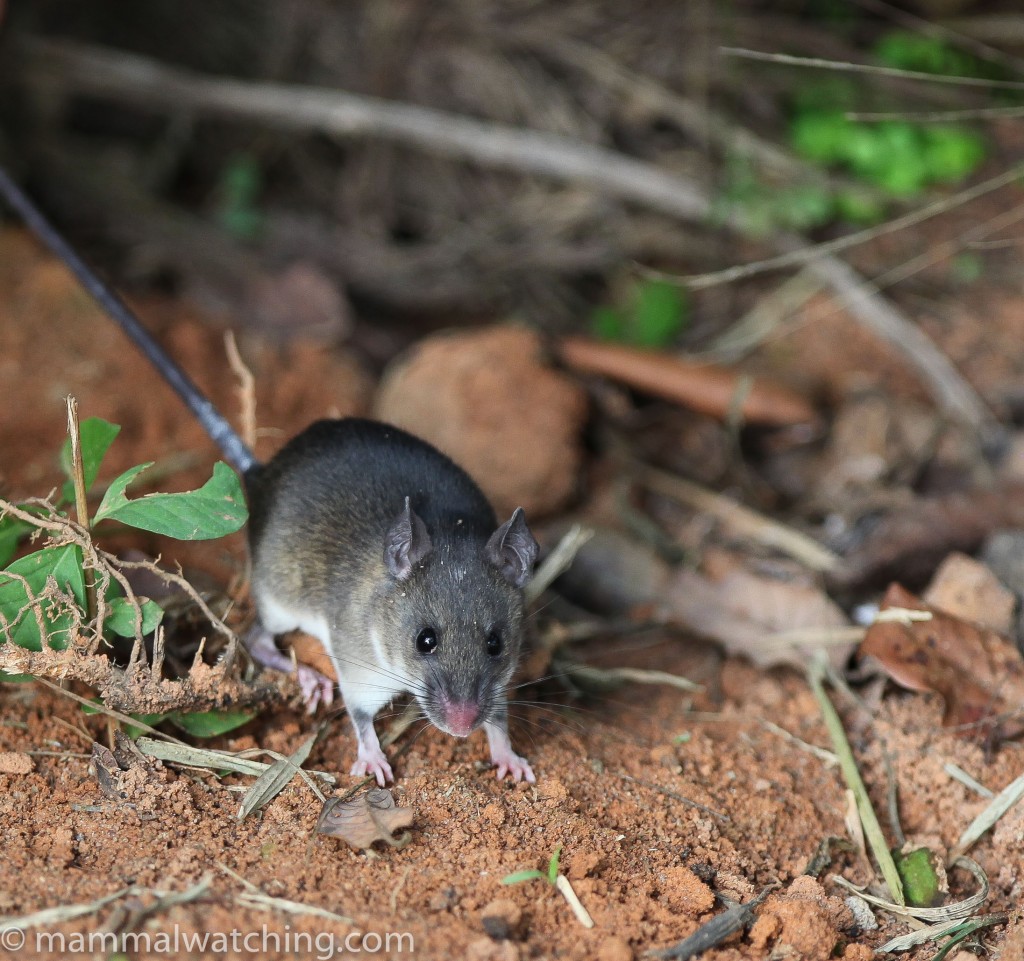
Soft-furred Mouse species, Praomys misonnei or P. petteri
We found one other species of Soft-furred Mouse, that appears to be either Praomys misonnei or P. petteri. The only other small mammal was a white-toothed shrew species which we were not able to identify at the time but were later told ought to be African Black Shrew (Crocidura nigrofusca), the only crocidura of that size with a non bi-colured tail in the area.
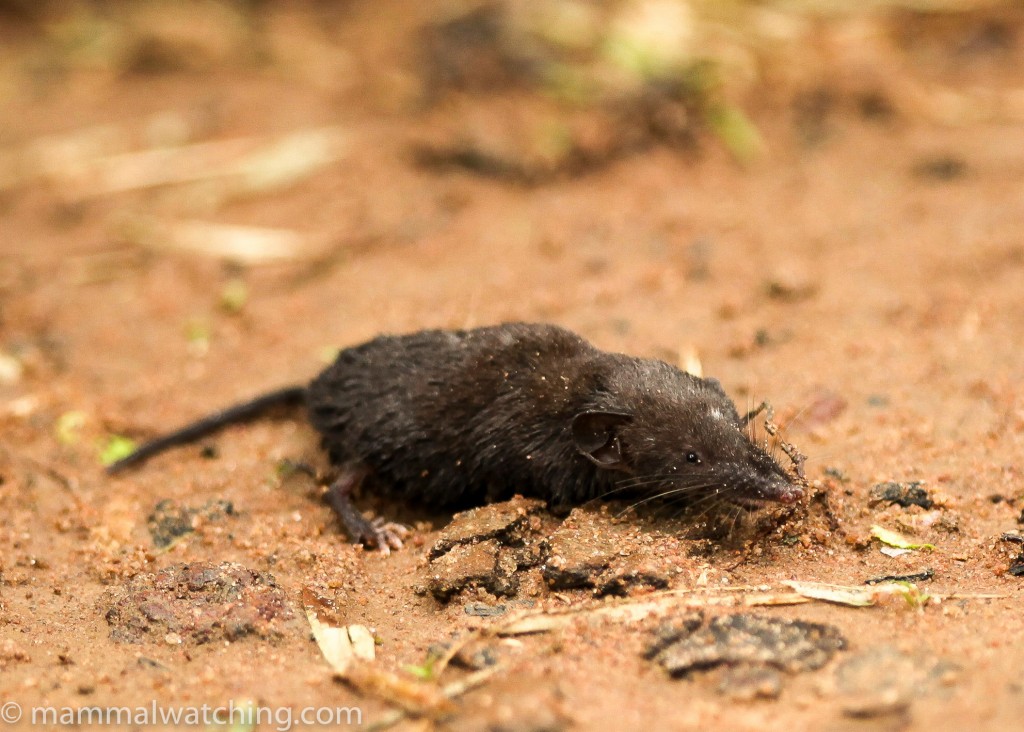
African Black Shrew, Crocidura nigrofusca
There were many bats flying around but they were hard to catch. J.M. did manage to catch the small bat patrolling the outside of the lodge dining room which proved to be a Bates’s Slit-faced Bat (Nycteris arge).
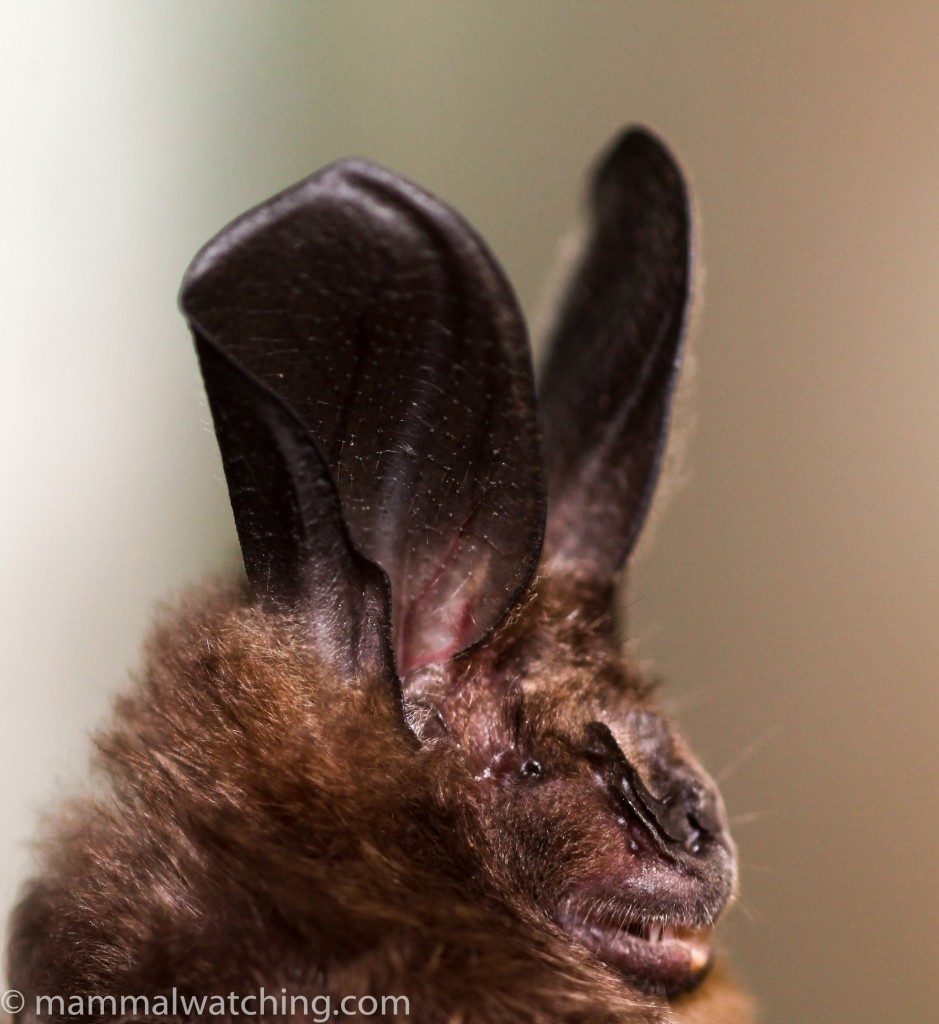
Bates’s Slit-faced Bat, Nycteris arge
We remain puzzled why it didn’t have the characteristic bifurcated tail which, according to Peter Taylor’s Bat’s of Central and Southern Africa, all Nycteridae have.
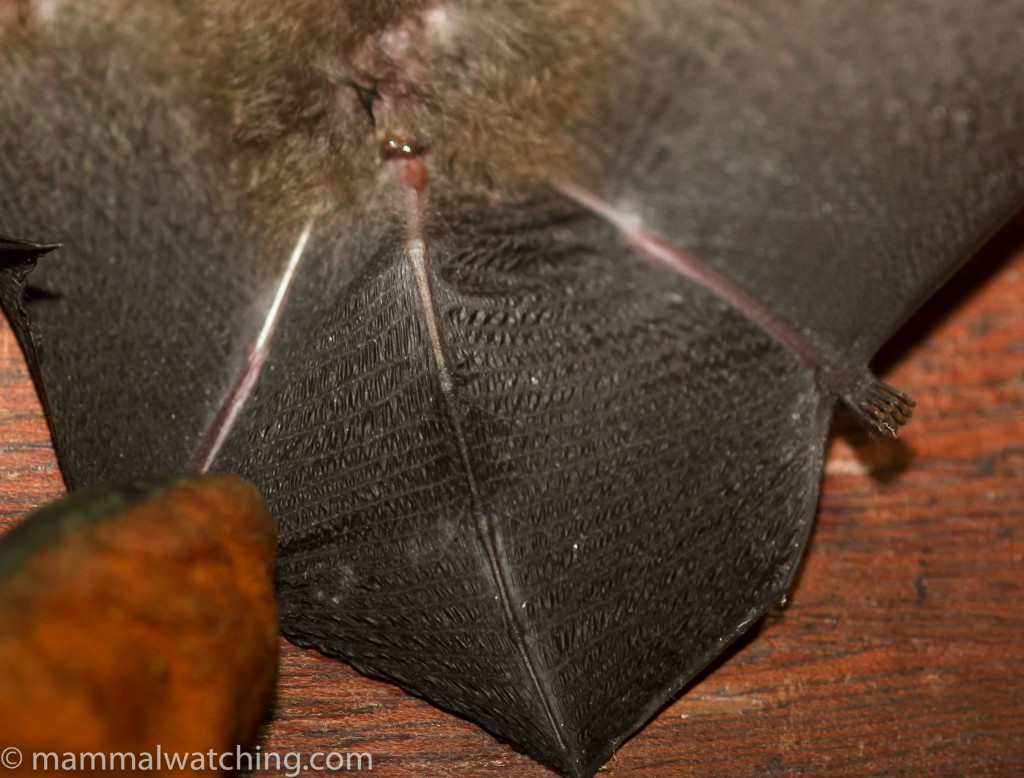
Bate’s Slit-faced Bat and its mysterious – non-text book, tail
One afternoon the Ba’Aka caught a great little golden mole in the forest, which we later identified as a Congo Golden Mole (Calcochloris leucorhinus cahni). I asked them to show the mole to Rod but it was never seen again, and presumably ended up as hors d’oeuvres on the Ba’Aka menu that evening
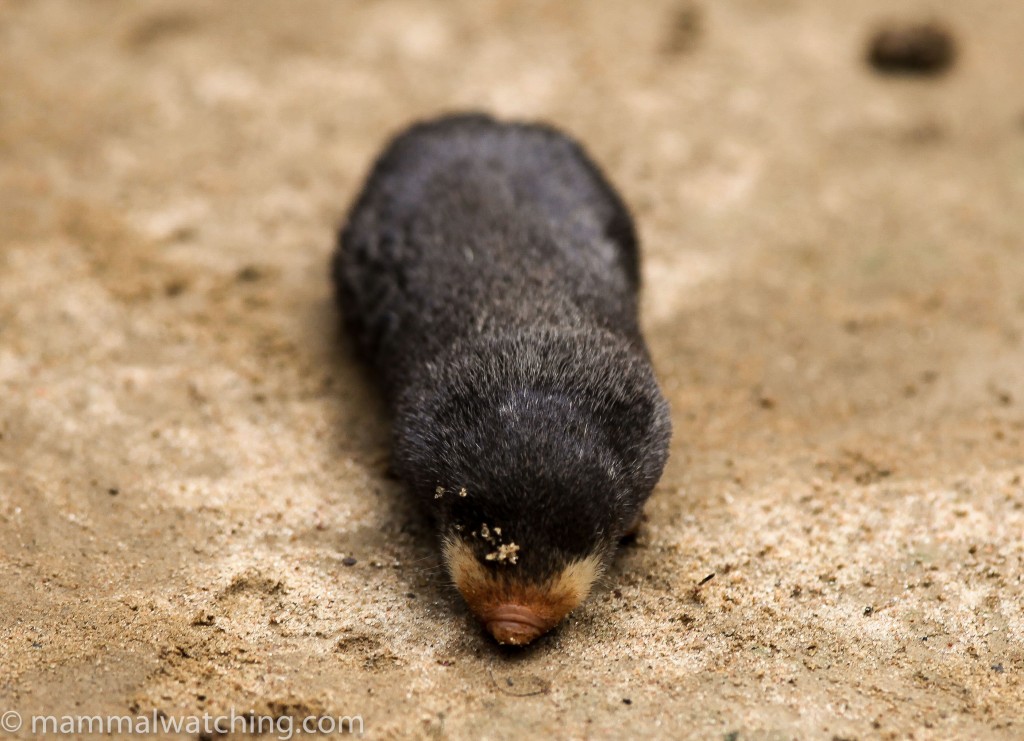
Congo Golden Mole, Calcochloris leucorhinus cahni
Dzanga Bai Mammals
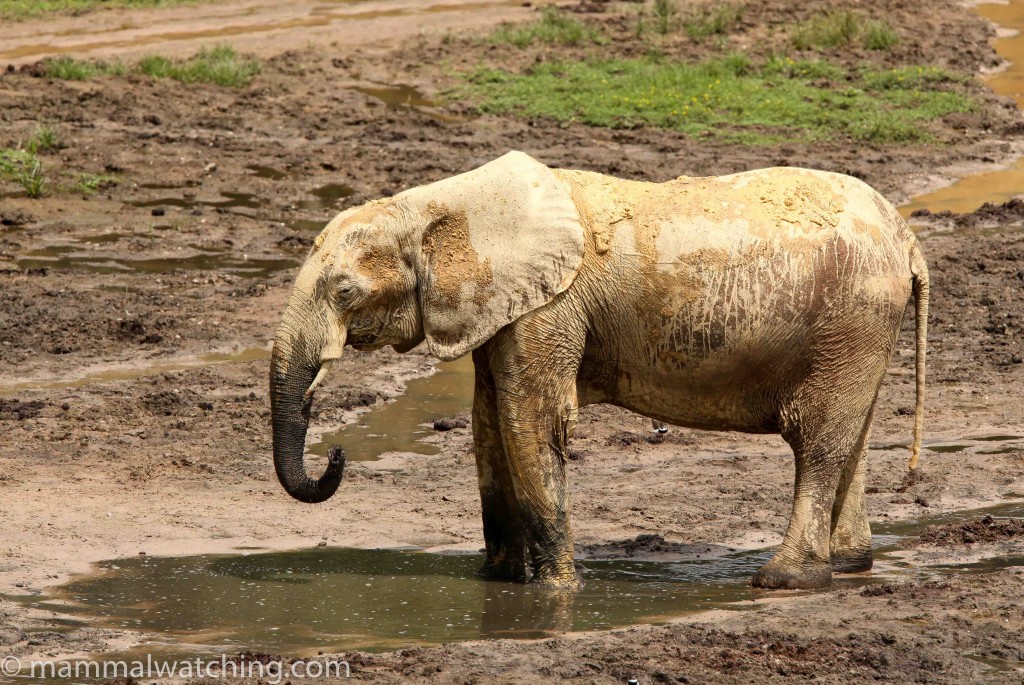
African forest elephant, Loxodonta cyclotis
Dzanga Bai is an hour’s drive from the lodge, though it could be much quicker with a better, drier, road as it is less than 20 km away. Before visiting the bai you must stop at the visitor’s centre next to Doli Lodge to arrange a guide and a Ba’Aka tracker and the earliest this can be done is 6.30 a.m. The Ba’Aka tracker was useful, the guide less so, especially our first – Olivier – who was without any value whatsoever. It is important that the park provides opportunities for local employment, just a pity that some of those employed have interest only in getting to the bai fast so they can sleep.
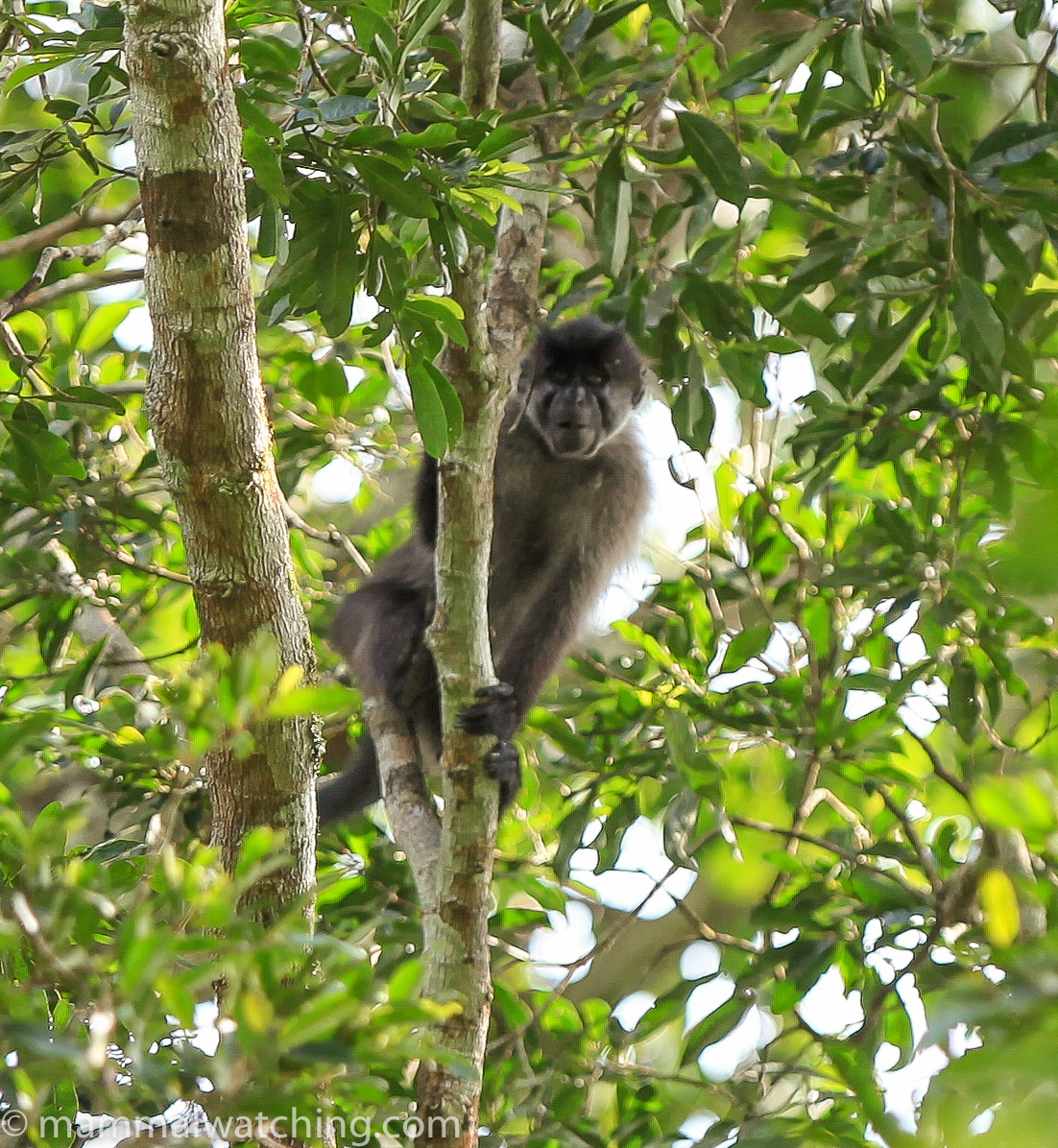
Grey-cheeked mangabey, Lophocebus albigena
We visited for one full day, and then again for an afternoon and also arranged an overnight stay there through contacts in the WWF. It is a 1.8 km walk from the parking area to the lookout tower, the first few hundred metres of which required wading through thigh deep water. If an Elephant blocked the route the Ba’Aka would chase it off with a few slaps of their machete on the water.
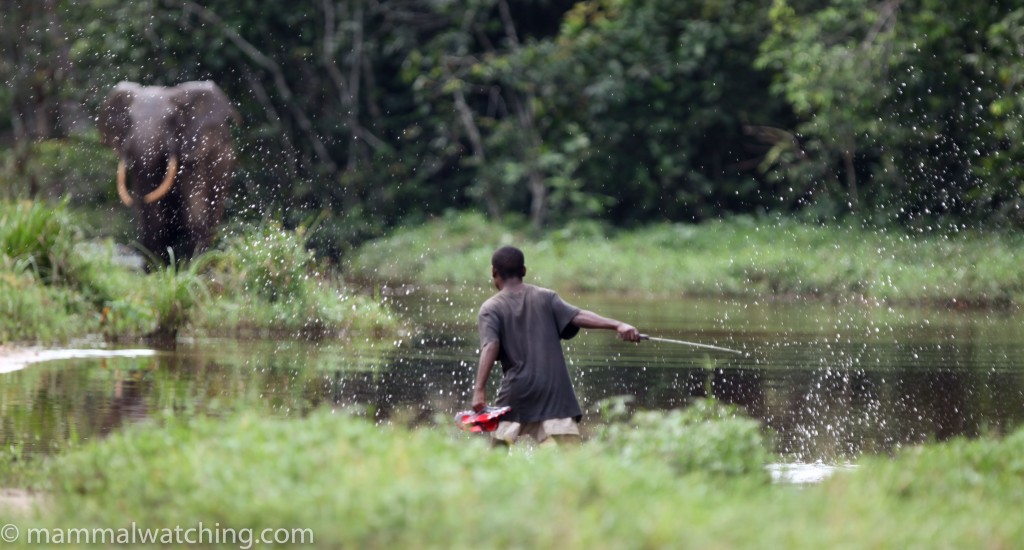
Monkeys are quite common and we saw Grey-cheeked Mangabeys and Crowned Guenons on the first morning, though our useless guide did not want to look for them, saying first that they were too far away, and then, when we saw the trees moving close by, that they were hiding. But we stood our ground and got good views. We heard Putty-nosed Monkeys on other days. Blue Duikers are also common in the forest and we saw several.
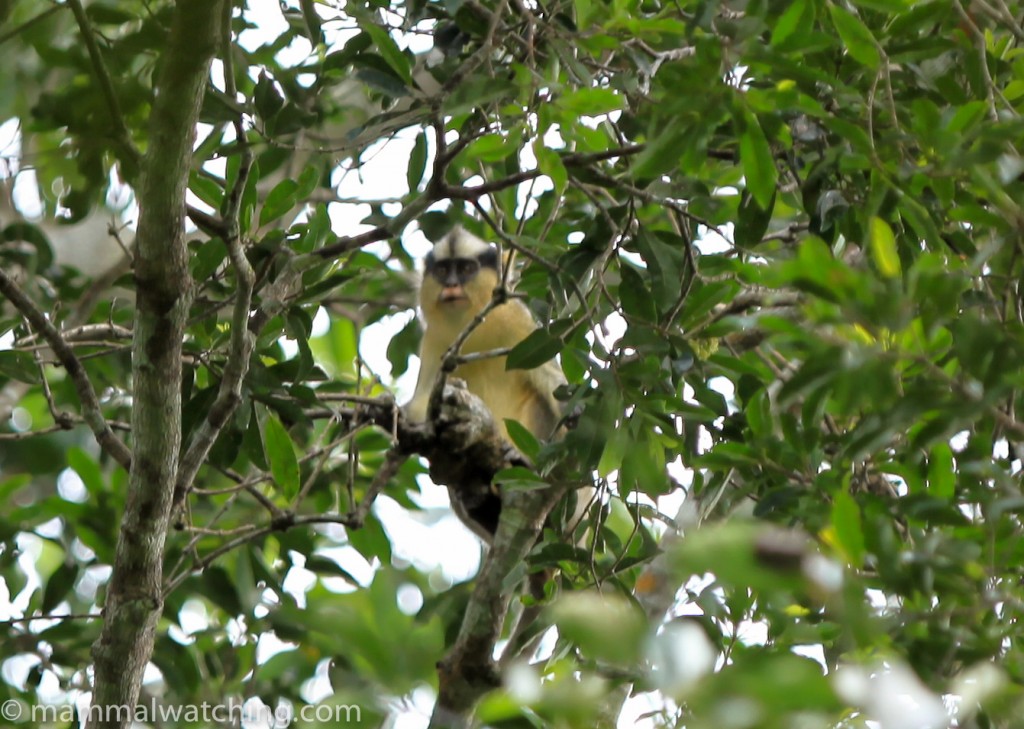
Crowned Guenon, Cercopithecus pogonias
The bai is just spectacular and one of the best wildlife encounters I’ve ever had. As you approach you hear the trumpeting and snorts of the elephants echoing over the forest like something straight from Jurassic Park. The viewing tower is about 10 metres high with space for 20 or so people. Forest Elephants and Sitatunga were omnipresent. There were between 40 and 110 Elephants in the Bai all of the time along with a handful of Sitatunga. Other species are harder to see. Watching and listening to the Elephants come and go and interact was superb. I’d imagined we’d see more diversity at the bai and was disappointed only to see Elephants and Sitatunga, plus a lone Buffalo once.
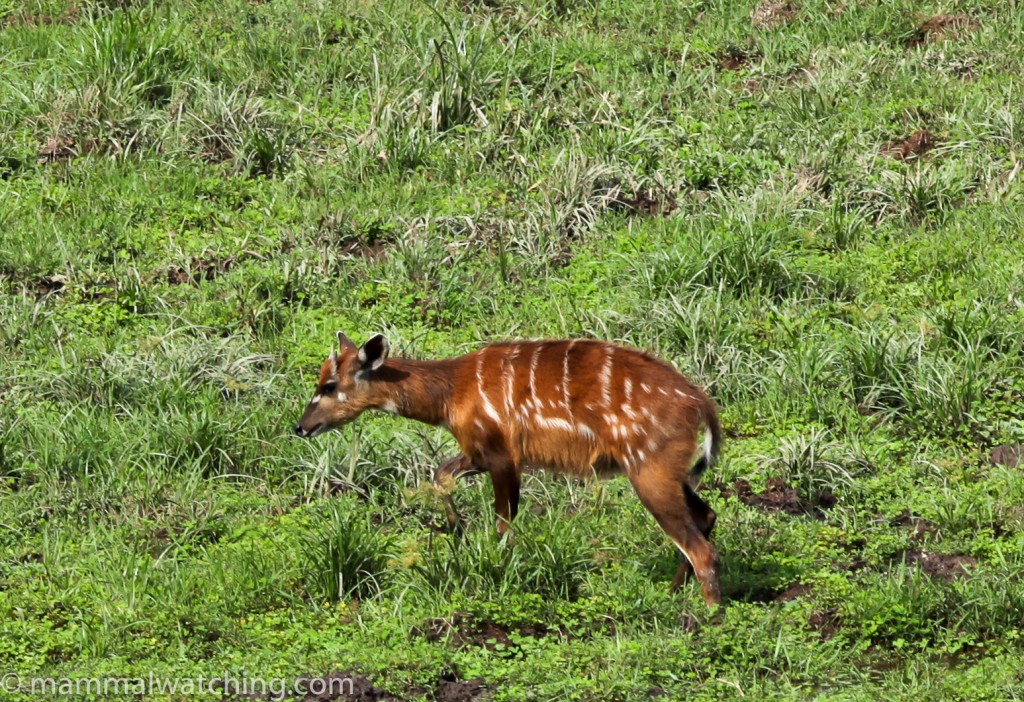
Sitatunga, Tragelaphus spekii
Giant Forest and Red River Hogs and Bongos, all of which we missed, are much rarer visitors (perhaps once a week in the wet?) though they are much more common in the dry season. Andrea Turkalo, an American researcher we spoke to has been studying the Elephants there since 1990, and has recorded more than 4000 individual animals using the bai! She told me a herd of Bongos was in the bai every day for 6 weeks around March/April 2011. Squirrels are quite often seen in the trees behind the bai though I am not sure which species.
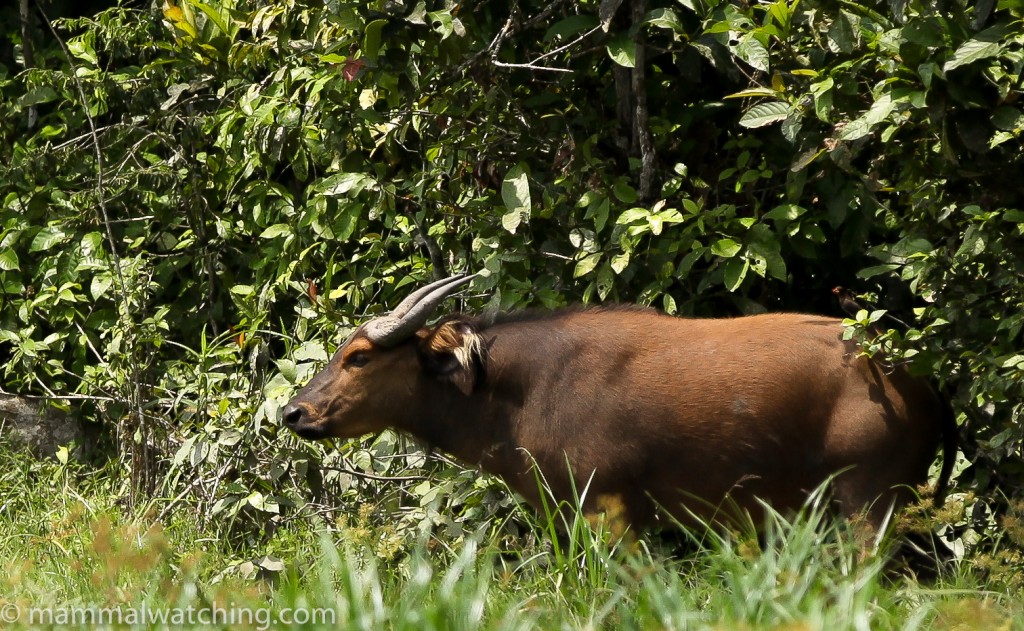
African Forest Buffalo, Syncerus caffer nanus
Staying in the tower overnight was a real privilege. I felt sure we’d see Giant Forest Hogs and Red River Hogs though we saw neither despite me sleeping for less than 2 hours: it was a full moon but unfortunately overcast until about 2am which didn’t help spot stuff (spotlighting the bai is forbidden).
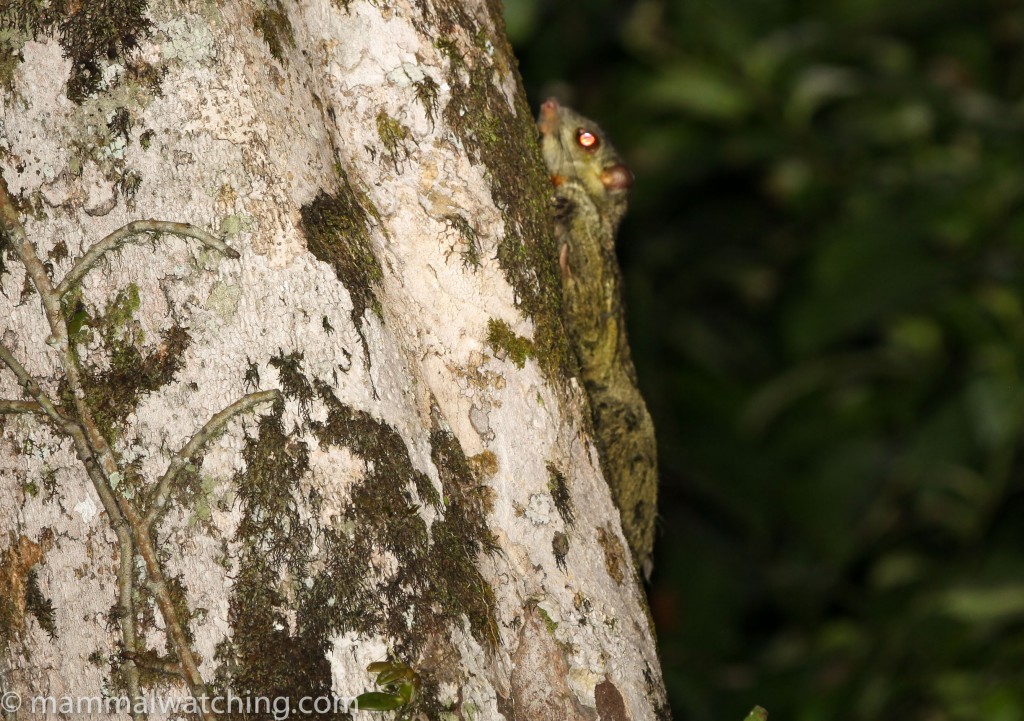
Beecroft’s Anomalure, Anomalurus beecrofti
We did see a Beecroft’s Anomalure on a tree right next to the hide, as well as a small mouse – another Hylomyscus species – that spent a good deal of effort trying to get into the biscuit packet.
Bai Hoku
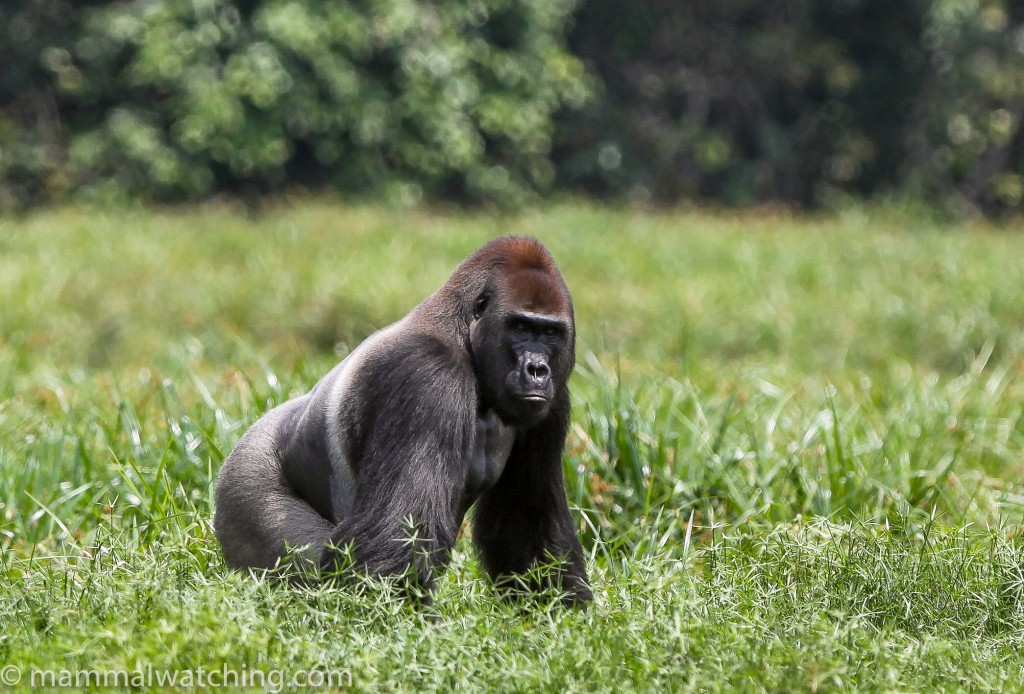
Lowland Gorilla, Gorilla gorilla
Bai Hoku is a gorilla research camp, an hour on from Dzanga Bai (and so two hours from Sangha Lodge), on a terrible road (when it was in better shape it used to take less than half the travel time). The camp is on the border of secondary and primary rainforest and is home to an habituated family of Lowland Gorillas and a large troop of habituated Agile Mangabeys.
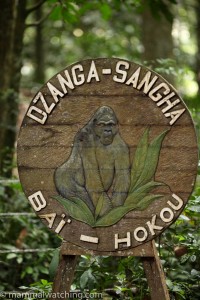
Apart from mangabey and gorilla watching you are also able to arrange Ba’Aka guided walks through the forest that stop in at some of the small and medium sized bais that are a mosaic in the forest (none is as impressive as Dzanga Bai). We visited three times. On our first trip we spent a wonderful hour with the Lowland Gorillas. They were very close to the camp – just 15 minutes – though can be much further. It was a much wilder experience than I had in Rwanda with the Mountain Gorillas. The Lowland Gorillas here seemed – at best – to tolerate us. Photographic opportunities (as so often here) were limited because we were watching the animals in dense forest and were required to keep at least 7 m from them.
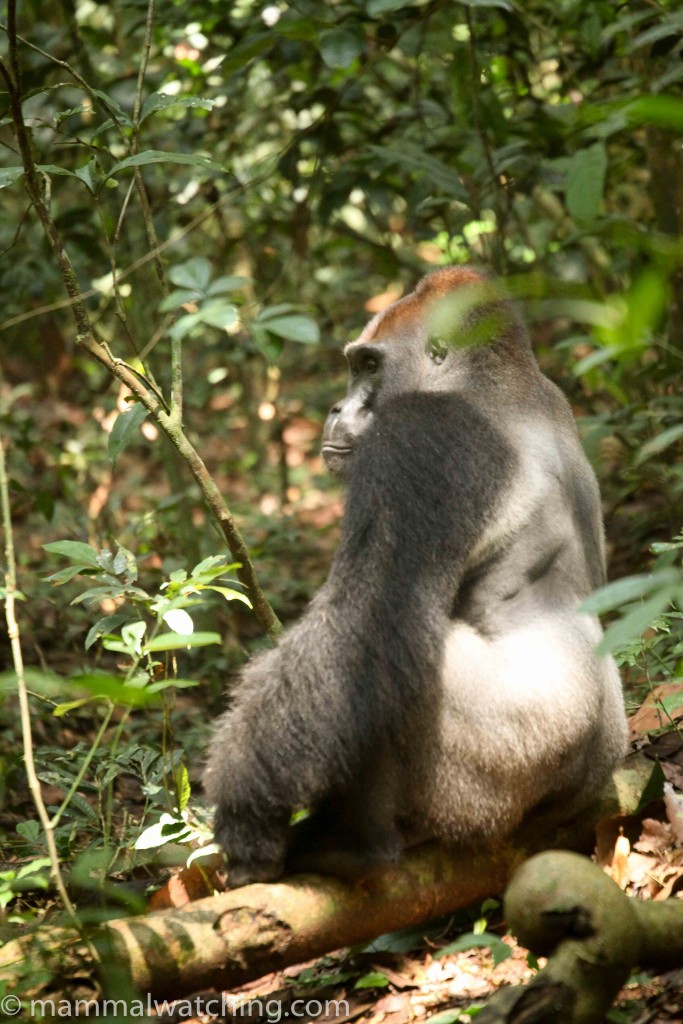
Lowland Gorilla, Gorilla gorilla
After the Gorilla watching we went looking for habituated Agile Mangabeys. They too were just 10 minutes from the camp. The troop is very large (250 or so) and they spend a lot of their time on the ground.
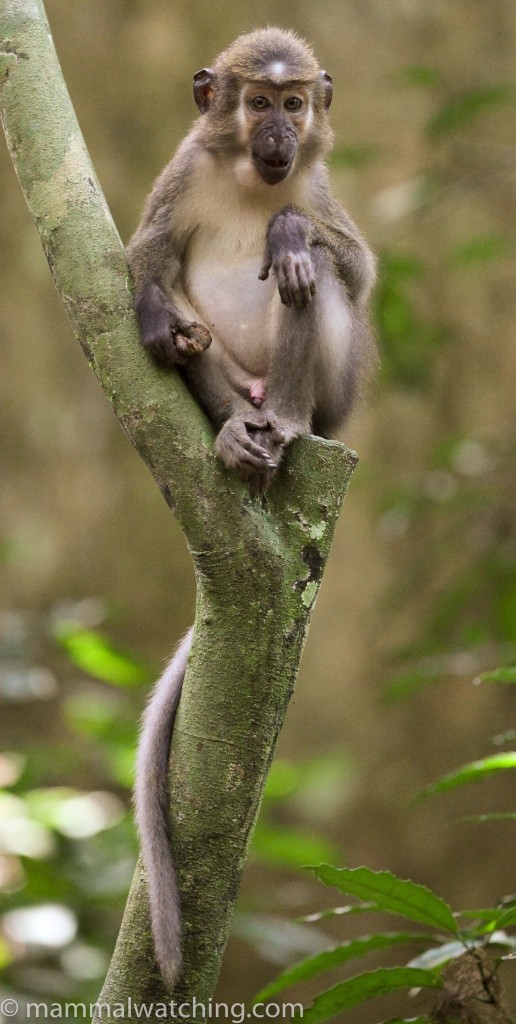
Agile Mangabey, Cercocebus agilis
We returned again twice to take bai walks (la tour de saline) which last for 2 to 3 hours. There is potential to see Bongos, Red River Hogs and other good stuff on these. Although there is a greater concentration of large mammals at Dzanga Bai, you have an opportunity to cover more ground at Bai Hoku.
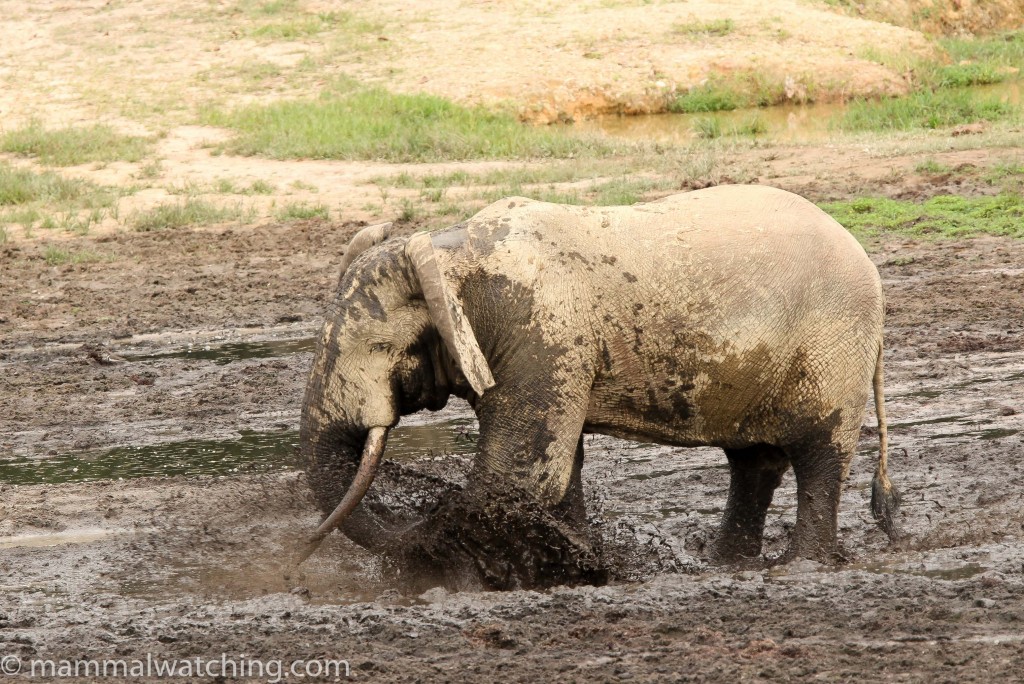
African forest elephant, Loxodonta cyclotis, Dzanga Bai
We saw a few Forest Elephants and Sitatungas, along with several Forest Buffalo in the Bais on both walks.
We also saw the same group of gorillas we’d seen during the gorilla tracking – wonderful to see them out in the open and foraging in a bai.
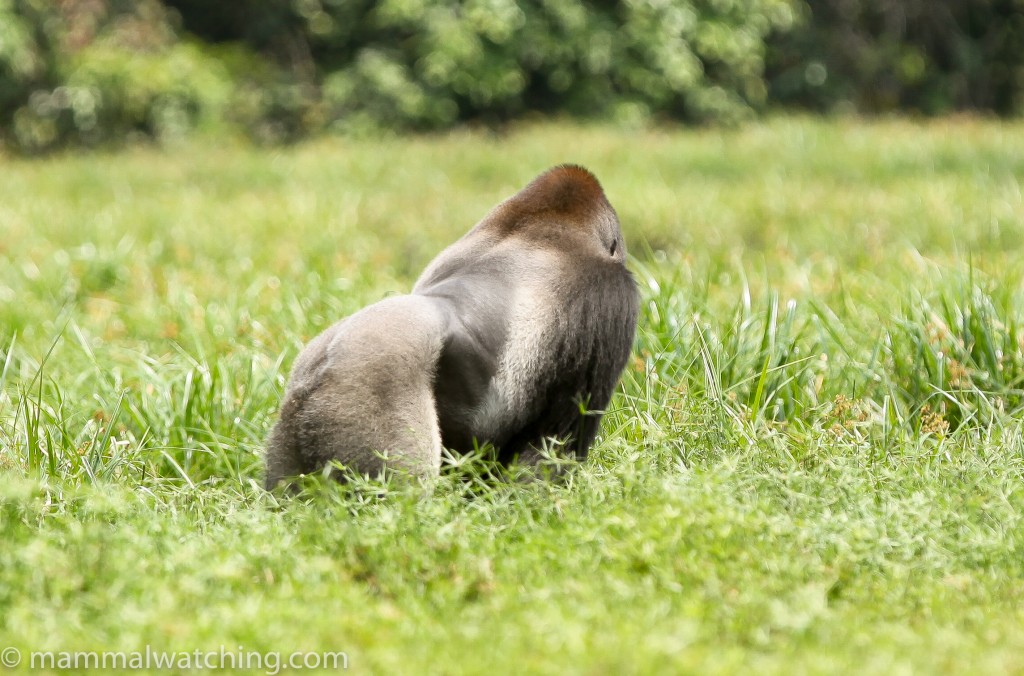
Lowland Gorilla, Gorilla gorilla
A waterfall, next to the camp, doubles as camp shower. A colony of Noack’s Roundleaf Bats (Hipposideros ruber) are roosting behind it and easy to see.
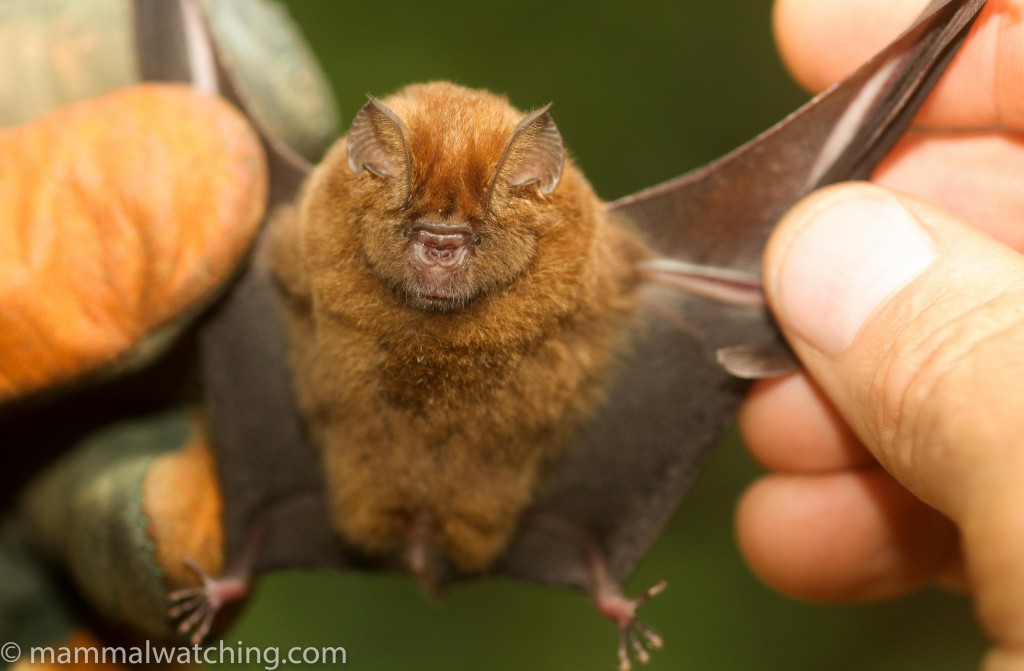
Noack’s Roundleaf Bat, Hipposideros ruber
Walking in the forest we saw a few Putty-nosed Monkeys and several squirrels which were hard to get good views of, though Jean-Michel got a clear look at a Fire-footed Rope Squirrel. Duikers are common in the forest in the evening and we saw several Blue Duiker at night and got fleeting glimpses of other animals in the day, at least two of which might have been Peter’s Duikers though the views were too poor to be sure. \
At night – walking along the trail from camp to the first bai – we got reasonable views of a Long-snouted Mongoose moving along the stream that runs into the bai right by camp. We heard Galagos and Hammer Bats too.
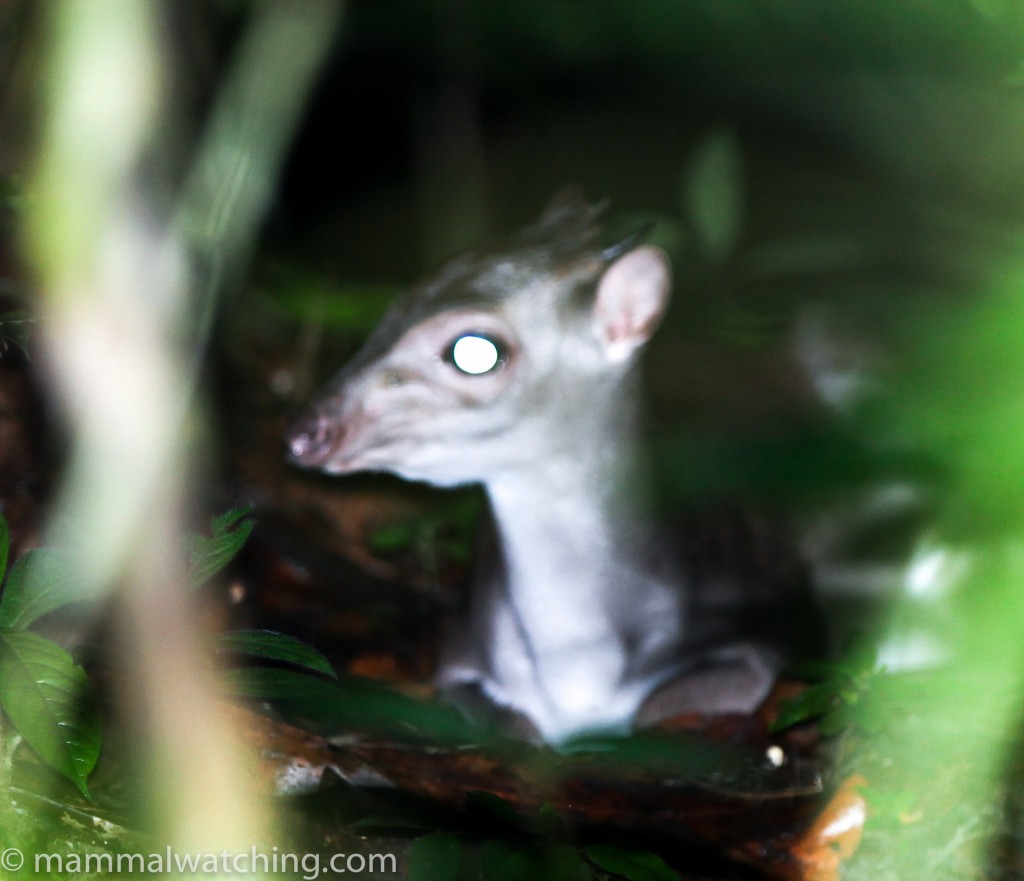
Blue Duiker, Philantomba monticola
Staying overnight in the camp was a lot of fun. A British Ph.D student had been living there or nearly two years and Saturday night was social night. It was memorable to sit with her and 20 pygmies watching the cheesy break-dancing movie “Step up to the Streets 2” on a laptop in the middle of the forest, hearing the Ba’Aka cheer and laugh as teh plot unfolded. An elephant came into camp that night to eat the soap and generally be a nuisance. It passed within a metre of my cabin though I didn’t hear it. So be cautious walking at night.
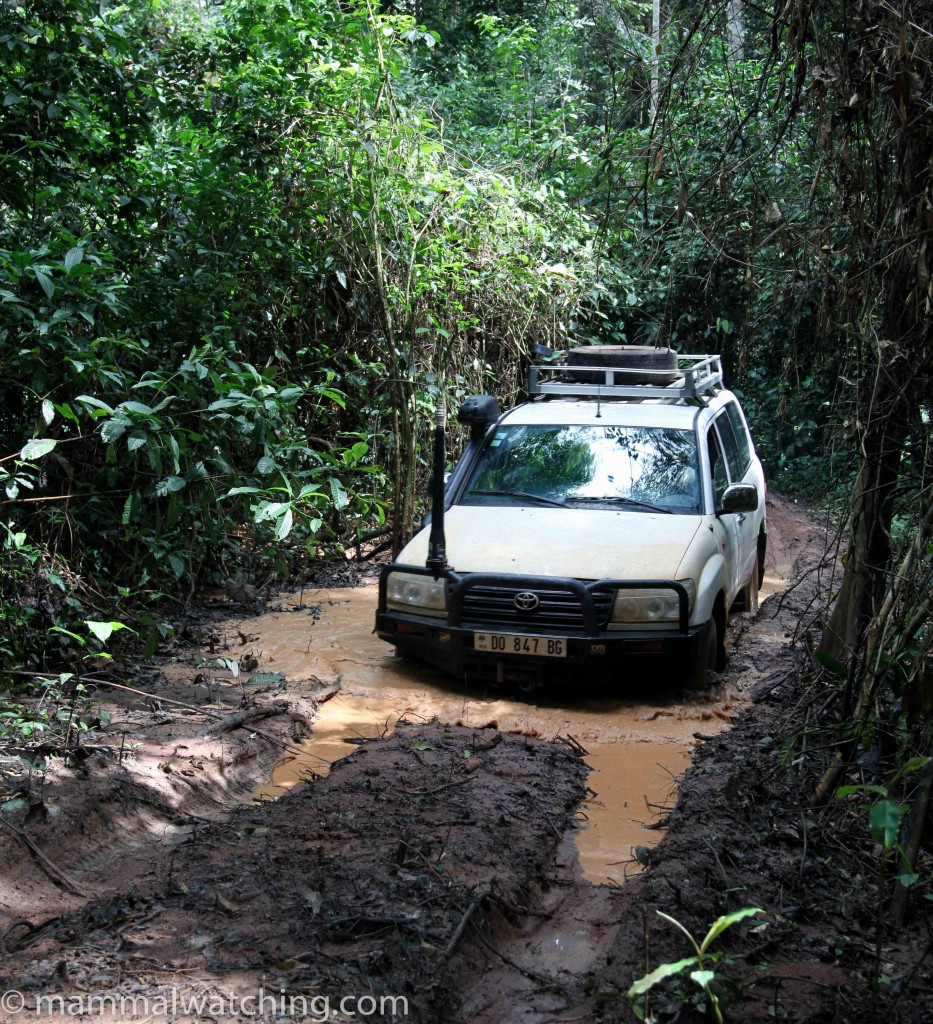
The Road to Bai Hoku
The muddy drive to and from the bai was also quite productive. We stopped quite often to move fallen trees and heard monkeys one time in three, seeing Moustached, Putty-nosed and Grey-cheeked Mangabeys. On our second drive into camp we saw a pair of gorillas on the road – about 5km before the camp – that were not from an habituated troop. And at about midday a Bay Duiker jumped in front of the car though I was ferreting through my bag looking for a book so missed it. Damnation!
Doli Lodge Mammals
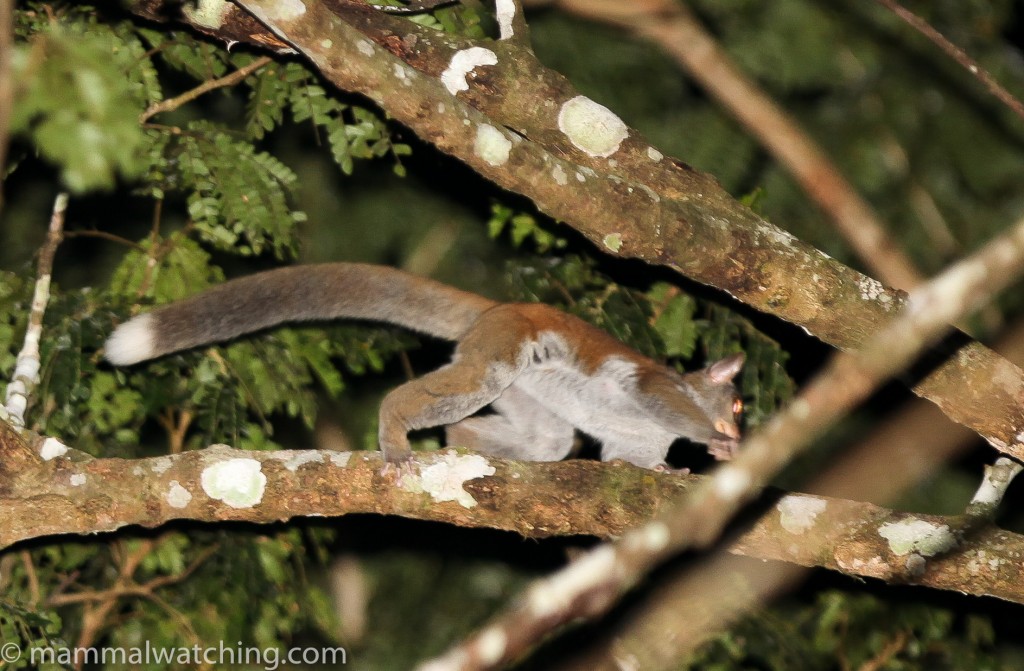
Elegant Needle-clawed Galago, Euoticus elegantulus
Doli Lodge is half an hour from Sangha Lodge. It looks quite nice and is a little more convenient for trips to Dzanga Bai etc. However, I very much doubt whether they are as focused on birds or mammals as Rod is in Sangha. We walked the roads between the lodge, the visitor’s centre and the WWF offices and guest house by day and night a couple of times.
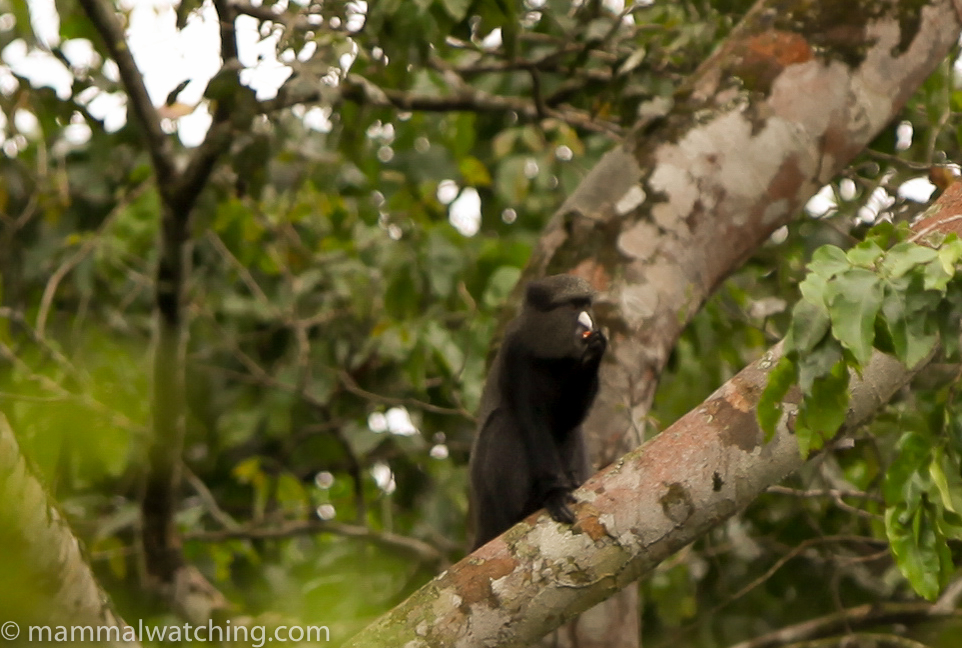
Putty-nosed Monkey, Cercopithecus nictitans
Several people told me that De Brazza’s Monkeys were common in the forest in the early morning (they are around Sangha too but best seen from the river). I looked twice without success, though did see a Red-legged Sun Squirrel early one morning.
We abandoned monkey spotting once rain started, and took a walk into the forest, which came to an abrupt end when we almost trod on a sleeping Elephant. It was lying – flat out – in the forest just 3 m from us, its ears flapping as it snored. During a second morning walk one of the Ba’Aka guides told me he had found some De Brazza’s Monkeys just off of the road. I saw movement in the trees and heard what I assume was them calling but could not see the animals (apparently they can remain motionless for 8 hours when the mood takes them).
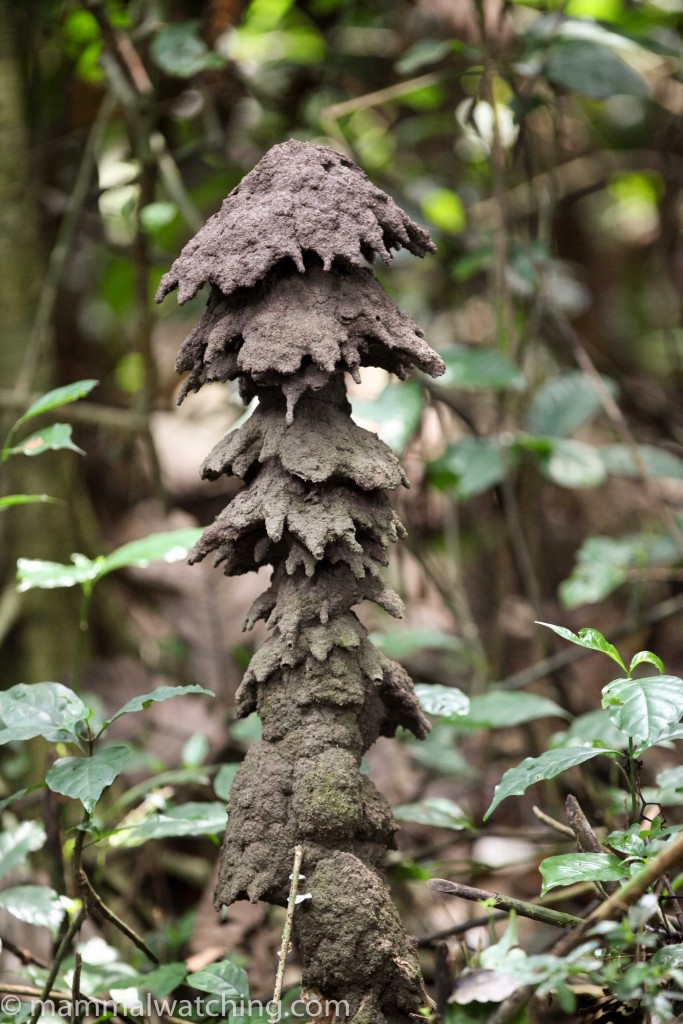
Congo fungus
There were many opinions about the best way to see De Brazza’s among the locals. One guy said there is some swamp forest along the road on the other side of Bayanga where they are common. Others recommended looking for them from a pirogue down the river where you could also look for Bayanga’s resident Hippos.
During two spotlighting walks (one in light rain) we saw well several Elegant Needle-Clawed Galagos, a few Milne-Edwards’s Pottos and a single Palm Civet on both nights. Rod had seen Servaline Genet, Beecroft’s Anomalure and a Long-tailed Pangolin around the lodge.
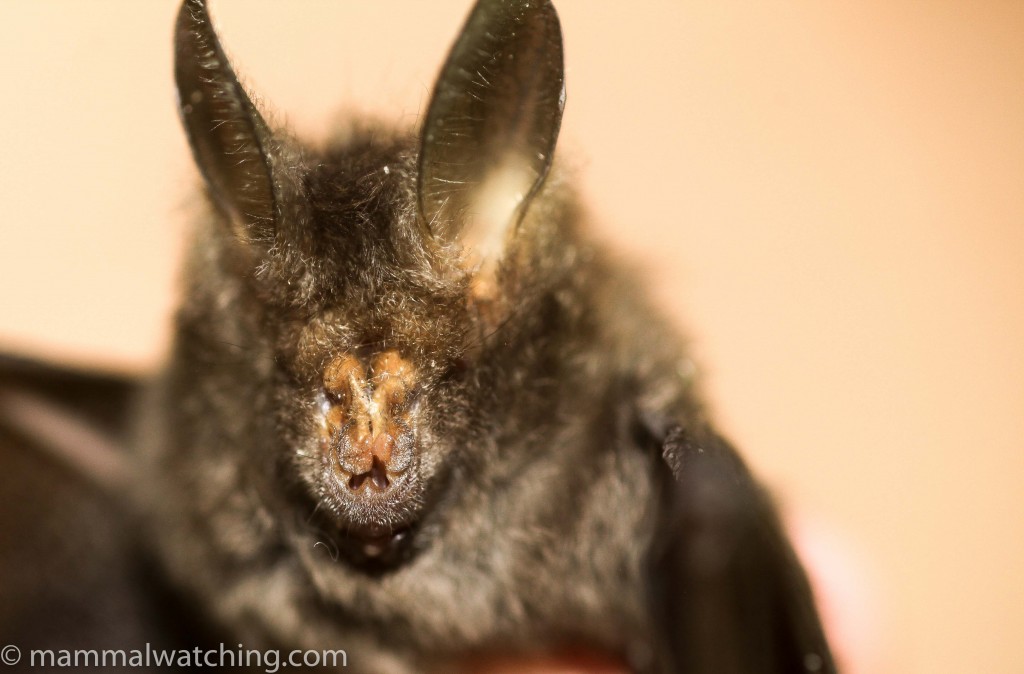
Hairy Slit-faced Bat, Nycteris hispida
One evening we were summoned to the lodge kitchen where a bat was flying around. Four of us tried to catch it using our shirts and aprons for 5 hilarious minutes. When we finally grabbed it, it turned out to be a Hairy-faced Slit-faced Bat: quite similar looking to the Bate’s Slit-faced Bat we’d caught at Sangha Lodge, but with bicuspid teeth and a yellow nose and tragus (along with the sort of bifurcated tail we’d read that Bate’s Slit-faced Bat is meant to have.
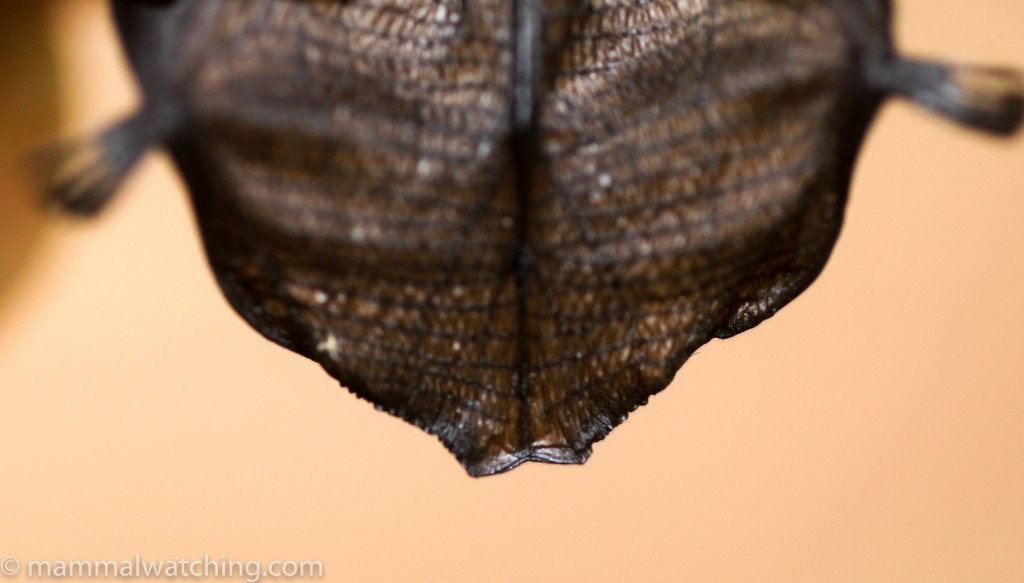
Hairy Slit-faced Bat, Nycteris hispida, text-book tail
During our trip we repeatedly ran into two German scientists: twin brothers trying to photograph as much biodiversity as possible during a 3 week stay. They saw similar species to us in many places but around the lodge they said they had seen a Linsang in the trees next to the WWF guest house and photographed a Western Tree Hyrax and a small galago too.
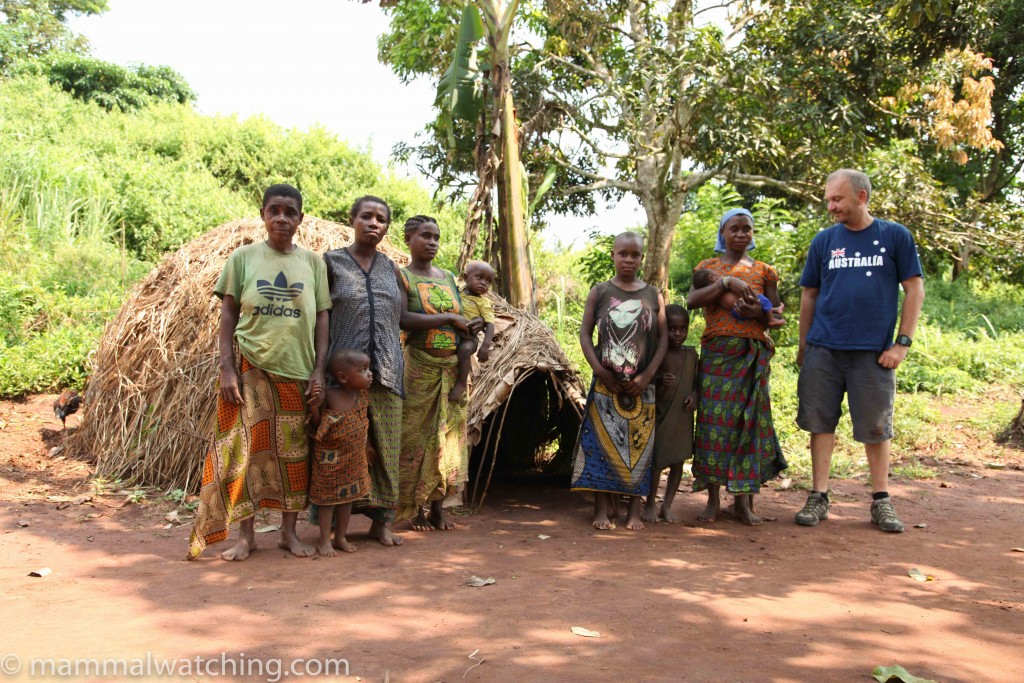
Ba’Aka Village
Leaving Sangha
On the way back to Bangui, Rod recommended we stay at a small tourist lodge called Buffle Rouge, which meant an hour or so’s detour off the main route. The lodge was much more comfortable than the Boda hotel we’d used on the way down, but was badly run and sort of annoying (for example we had to eat with two German tourists who were friendly but incredibly slow eaters – they made the meal stretch out to twice its normal length while I tried not to fall asleep at the table). In all fairness I was tired and cranky not to be at Sangha Lodge any more.
It is in some reasonable forest so some animals might have been possible: Rod had seen Servaline Genet and Pottos while spotlighting around the tiny island the lodge is on, along with Striped Ground Squirrels on the road out in the day time. But I was exhausted and didn’t see anything during some half-hearted spotlighting. We saw nothing the next morning during the drive out.
Sangha Lodge and Dzanga Sangha park are truly wonderful places. They lived up to my expectations even if they were a little different to what I expected – the lack of Bongos and Red River Hogs was a disappointment but not enough of one to detract from the trip. I miss the river, the Ba’Aka, and the animals as well as having a beer with Rod and swapping mammal stories. I am looking forward to getting back – in the dry season – as soon as I can.
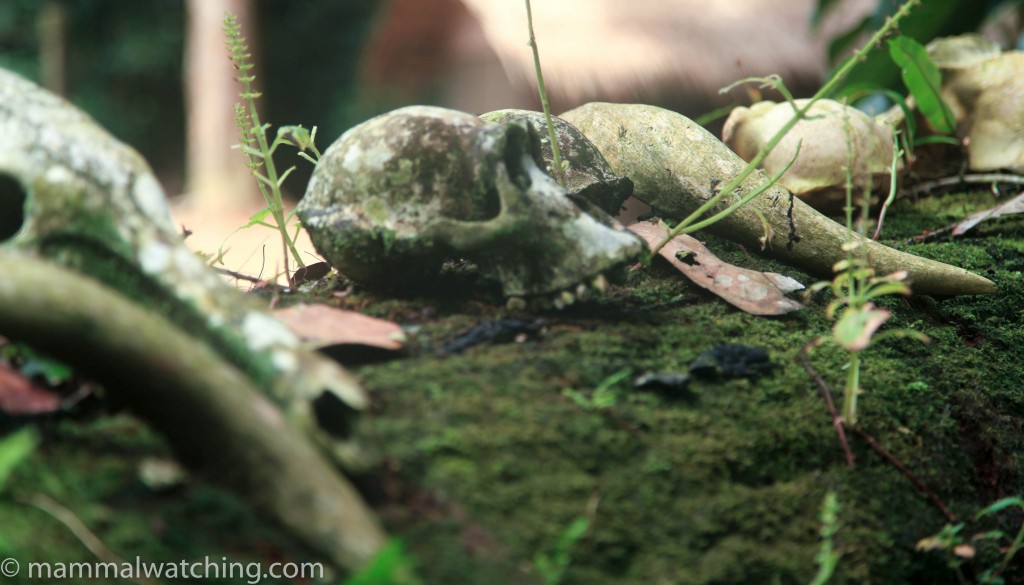
Gorilla skulls, Bai Hoku
Trip List
36 species of which 1 – Peter’s Duiker – was a possible, 2 were heard and not seen (Hammer Bat and Western Tree Hyrax), and a further three await identification to the species level (Hylomyscus, Praomys and Crocidura spp). Eighteen lifers for me. Not a bad haul!
1. Lowland Gorilla. We found the habituated group at Bai Hoku within 15 minutes of leaving camp on our gorilla trek. We saw two non-habituated gorillas on the road the next day (about 5km before Bai Hoku) and saw again the habituated group out in the bai that morning during a bai walk.
2. Guereza Colobus. One of the rarer primates around the forest, we saw a couple very near Sangha Lodge early one morning.
3. Agile Mangabey. We got to the habituated group at Bai Hoku within 10 minutes of leaving camp. We saw a couple more animals during one of the walks out of Bai Hoku.
4. Moustached Monkey. One of the commoner primates apparently though we only saw one group (on the road to Bai Hoku). This monkey was commonly for sale as bush meat along the road from Bangui.
5. Putty-nosed Monkey. The most commonly seen and heard monkey and we saw them well in every area.
6. Crowned Guenon. We saw these several times, around the lodge and on the road to Bai Hoku, as well as at Dzanga Bai. They were often in the company of other monkeys.
7. Grey-cheeked Mangabey. We saw these a few times near Dzanga Bai and on the road to Bai Hoku.
8. Milne-Edwards’s Potto. Quite common close to both Sangha and Doli Lodges.
9. Thomas’s Galago. We saw several small galagos close to Sangha Lodge leaping around dense vegetation a few metres above the ground. Rod thought – on the basis of the calls he heard every night – that they were all Thomas’s Galagos around the lodge (rather than the very similar Demidorff’s).
10. Elegant Needle Clawed Galago. We saw several of these near the WWF guest house (next to Doli Lodge). Presumably this is the larger galago we saw more distantly near Sangha Lodge.
11. Straw Coloured Fruit Bat. Not a species I made any effort to see, but a few were flying around the Gendarmerie HQ in Bangui which helped pass the time while Jean-Michel was being questioned.
[12. Hammer Bat. I may have seen this species near Sangha Lodge but just as I got onto a bat I was attacked by ants and lost it. Jean-Michel heard one calling in the middle of the night while we were at Bai Hoku.]
13. Noack’s Round-leafed Bat. Easily seen and caught in their roost behind the waterfall at Bai Hoku.
14. Bate’s Slit-faced Bat. We caught one that was patrolling the outside of the dining room at Sangha Lodge.
15. Hairy-faced Slit-faced Bat. We caught one in the kitchen at Doli Lodge.
16. Congo Golden Mole. The Ba’Aka at Sangha Lodge caught one of these great animals in the forest. One of my favourite mammals on the trip.
17. African Black Shrew . We caught a couple in the forest behind the lodge. Difficult to ID at the time, even though we sent a skull to a museum in France, but it seems this is the only species that fits the description.
18. Lady Burton’s Rope Squirrel. One sunny morning these were everywhere around Sangha Lodge, with a very distinctive and repetitive call. But only for one morning.
19. Fire-footed Rope Squirrel. Jean-Michel saw one of these while we were looking for another (I think different) squirrel we had just seen on one of the walks out of Bai Hoku.
20. Red-legged Sun Squirrel. The commonest squirrel around Sangha Lodge.
21. Green Bush Squirrel. Jean-Michel saw one cross the road in the mid morning a couple of hours past Boda on the drive from Bangui to Sangha.
22. African Giant Squirrel. Great views of an animal during a river trip from Sangha Lodge.
23. Beecroft’s Anomalure. Rod has seen these around Sangha and Doli Lodges. We didn’t but saw one on a tree right next to the Dzanga Bai hide at 9pm (if you are facing the bai the tree was on the left of the hide).
24. Greater Cane Rat. Very nice views of an animal sitting on the middle of the road about 2 hours before Boda at around 8.30pm (Lesser Cane Rats do not appear to reach the C.A.R).
25. African Woodmouse sp (Hylomyscus alleni or H. walterverheyni). One hylomyscus species was very common around the lodge and we saw a few including one caught by Rod’s cat and another at night in the tower at Dzanga Bai. Expert opinion is that they were either of these species but it is not possible to know which.
26. Soft-furred Mouse Species (Praomys misonnei or P. petteri). We caught one other mouse species noticeably greyer than the more abundant rufous wood mice. Again people more expert than me believe it was one of two Praomys species but it isn’t possible to know which from our photos.
27. Congo Clawless Otter. I was sitting on the steps up to the lodge at 6.30 am drinking a coffee when an otter cruised past and out into the river. There were already people crossing the creek to the lodge so its well worth putting in a few hours in the morning looking for this species.
28. Long-snouted Mongoose. This was another of the best mammals of the trip, largely because I hadn’t expected to see one. We spotted eye shine along the little creek that leads into the bai nearest Bai Hoku camp and followed the animal for a minute or so as it foraged along the creek. Kathryn, the gorilla researcher, who had been living in the camp for nearly 2 years, said she had seen one once sniffing around camp.
29. African Palm Civet. These great animals were surprisingly common. We saw several most nights while spotlighting around Sangha Lodge and one or two near Doli Lodge.
30. Forest Buffalo. This sub-species, strikingly different looking to the Savannah Buffalo, was less commonly seen than I had expected. We saw just one at Dzanga Bai for half an hour at dawn, and a few both times we took the bai walk out of Bai Hoku.
31. Sitatunga. There were 5 or 6 in Dzanga Bai most of the time. We spotted a couple on each of the bai walks.
32. Blue Duiker. The commonest duiker in the forest and particularly easy to see (and get good views of) at night around Bai Hoku camp. Otherwise just shadowy glimpses of animals mainly on the walks to and from Dzanga Bai.
[33. Peter’s Duiker. We may have seen this species once or twice around Bai Hoku. But I can’t be sure.]
34. Bay Duiker. Jean-Michel saw this species leap in front of our car as we were driving out of Bai Hoku at about 11 a.m.
35. Forest Elephant. Generally anything from forty to over a hundred in Dzanga Bai. We also saw a couple of animals during walks to and from the bai, along with a few others on the bai circuit at Bai Hoku. At times they are common around Sangha Lodge though happily not when we were there (their presence would have been something worse than ants to worry about when spotlighting). We heard a couple around Doli Lodge and almost stepped on a sleeping one.
[36.Western Tree Hyrax. We heard this species every night at Sangha Lodge with their ridiculously loud call, but they were never close enough to search for. In any case they seem notoriously hard to see. The German scientists saw one near Doli Lodge however.]
Stuff I missed
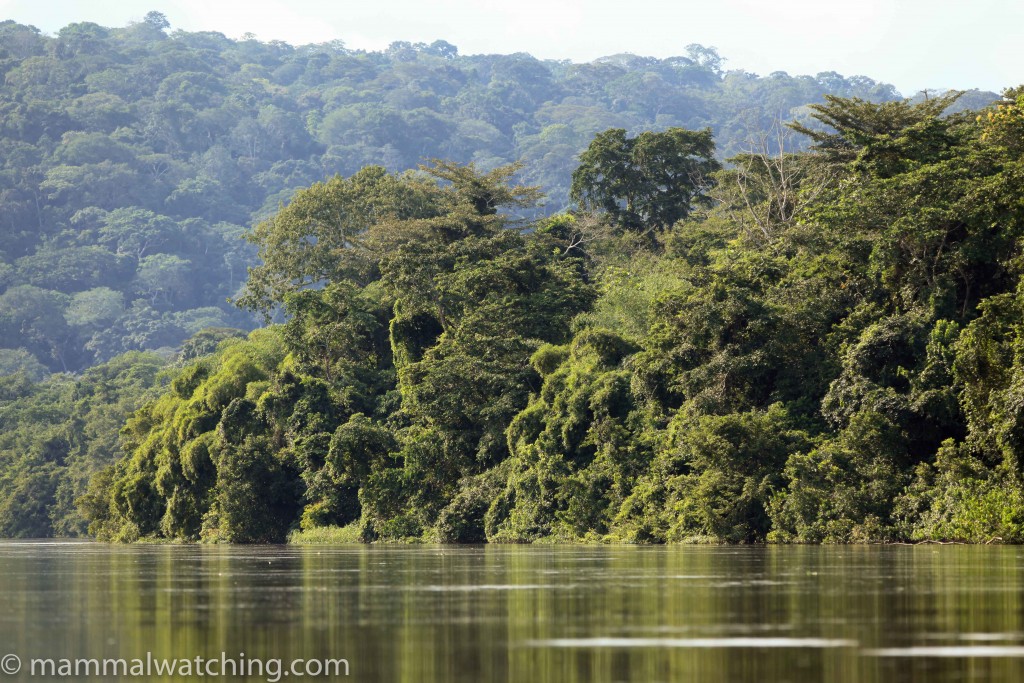
The trouble – or perhaps the joy – of Sangha is that the mammal list is interesting but many species are seen only very occasionally. It takes time. And there is a lot of forest to explore. Some of the species I thought I had a good to reasonable chance of seeing but missed were:
De Brazza’s Monkey. I really should have seen this and was below a tree an animal was sitting in. With another day at Sangha focused on this I’m pretty sure I would have seen one.
Bongo. Not seeing a Bongo was the biggest disappointment of the trip. They hadn’t been seen at the Dzanga Bai since October 28, 9 days before we arrived and so far as I know they weren’t seen during our stay. Occasionally seen on the road or the trails, Dzanga Bai is the best place to look. They are much more common in the dry season.
Red River Hog. The second biggest disappointment of the trip. These are fabulous pigs and I felt sure we would see some during our night at Dzanga Bai (the German brothers saw a sounder of 20 or so come in after dark a few nights before we stayed there). Again easier to see in the dry season I think.
Giant Forest Hog. Another species I thought we would see during our night at Dzanga Bai. The Germans photographed one at dusk on the edge of the Bai. But this species is easier to see in Uganda and Kenya I suspect (and indeed I saw many the following week in Abderdare National Park in Kenya).
Hammer Bat. Jean-Michel heard one but we didn’t see any of these spectacular bats.
Black Hawk Bat. An interesting species that Rod sees frequently hawking over the river at dusk. I kept looking but didn’t see one. Rod said they were common in Bayanga but somehow I never managed to get there to look at night.
Duikers. I was a little disappointed at the lack of duiker species. We saw several Blue Duikers and Jean-Michel saw a Bay Duiker. But it would have been nice to have seen a Peters or a Black-fronted Duiker (perhaps we did, but we didn’t get good enough views to be sure of many of the duikers we saw).
Western Tree Hyrax. Frustrating to hear their loud cries all the night around Sangha Lodge but never to see one. They are occasionally spotted.
Servaline Genet. I really should have seen one of these. They are supposed to be quite common around Doli Lodge in particular.
Tree Pangolin. These seem to be the commonest pangolin in the area and I’d hoped the Ba’Aka could have found one even if I couldn’t.
Allen’s Galago. Not a species I had thought we’d see but the Germans saw what they thought was this species at night in Bai Hoku. They are a ground feeder and confined to primary forest with an open under-storey so would be unlikely around Sangha or Doli Lodges. The current range for this species does not get close to the C.A.R so further information is needed on this sighting.
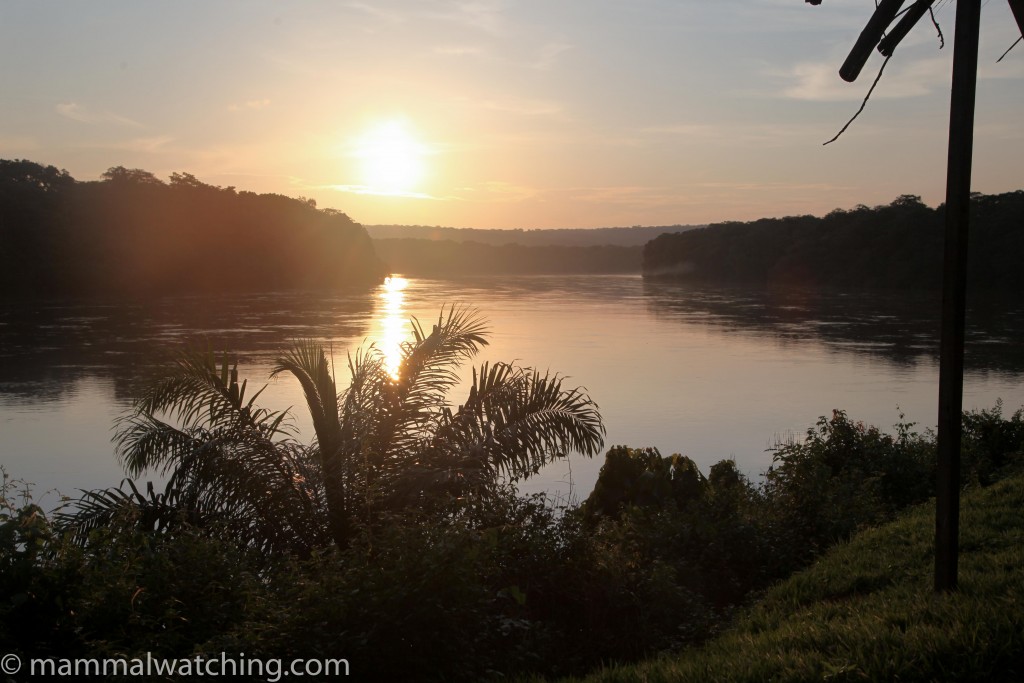
Community Reports
The World’s Best Mammalwatching
Sangha Lodge is almost certainly the reason you want to visit the C.A.R. in the first place. But, just in case you didn’t know, Africa doesn’t get any better. Western Lowland Gorillas, hundreds of Forest Elephants, Bongos and much much more are in and around this remote lodge slap in the middle of Africa. See more of the World’s Best Mammalwatching.
Several people have used a local operator called Jean Pierre Somon to make arrangements for travel around the C.A.R. I heard in March, 2016 from several sources that this once reliable operator is no longer recommended.
Lobeke NP (Cameroon) & Dzanga-Sangha (Central African Republic), 2023: Pictus Safaris, 2 weeks & 38 species including – in the C.A.R – Black and White-bellied Pangolins, Giant Forest Hog and Bongo.
Sangha Lodge, 2019: Mathias D’haen, 5 days & species including Bongo and Giant Forest Hog. Mathias took an interesting route to the park, by river, that allows the options of combing the park with Odzala or Nouabale Ndoki National Parks.
Sangha Lodge, 2019: Nancy Law, 1 week and many mammals including Long-tailed Pangolin, Giant Forest Hog and Bongo.
Sangha Lodge, 2018: Ewan Davies, 3 weeks & 37 species including Gabon Squirrel Galago, De Brazza’s Monkey and Giant Forest Hogs.
Sangha Lodge, 2018: Charles Foley, 9 days & 35 species including Bongo, Giant Forest Hog, Red River Hog, Brush-tailed Porcupine and Long-nosed Mongoose.
C.A.R, 2017: Daniel Hoops, 1 week & around 25 species including Bongo, Giant Forest Hog and Lord Derby’s and Beecroft’s Anomalures.
Sangha Lodge, 2017: Tomer Ben-Yehuda, 10 days and 40+ species including Congo Clawless Otter, Tree and Black-bellied Pangolins, Giant Forest Hog and De Brazza’s Monkey.
Dzanga Sangha, 2015: Venkat Sankar, 1 week & 32 species including Tree Pangolin, Brush-tailed Porcupine, Lord Derby’s Anomalure and Bay Duiker.
Dzanga Sangha, 2013: Dominique Brugiere, few days & great species including Long-tailed Pangolin, Black-fronted, Peter’s, Bay and Yellow-backed Duikers, Congo Clawless Otter, De Brazza’s Monkey and Bongos. Wow.
Dzanga Sangha, 2012: Coke, Som and Cokie Smith, 10 days & 36 species including Long-tailed Pangolin and Bongos.
Dzanga Sangha, 2012: Carmen and Torbjörn Lundqvist, 11 days & 28 species including Bongos and Lord Derby’s Anomalure.
Dzanga Sangha and Nouabalé-Ndoki, 2010: Sjef Ollers, 3 weeks and 23+ species including Lowland Gorilla, Brush-tailed Porcupine and Red River Hog.
Dzanga Sanga (2010): A report in Spanish with nice pictures. Part 2 is here.
Also See
A Space in the Heart of Africa, a stunning 50 minute wildlife documentary on YouTube, partially filmed in Dzanga Sangha and Epulu in the DRC. It features sone of the congo rainforest’s mega mammals including Bongo, Aquatic Genet, White-bellied Pangolin, Otter Shrew, Bates’s Pygmy Antelope and more!
Resources
Listen to Rod Cassidy from Sangha Lodge on the mammalwatching podcast, September 2024
The Sangha Lodge website is nice to drool over.
And here is the mammal list for Sangha (as at 2022). Wow.


Leave a Reply
You must be logged in to post a comment.